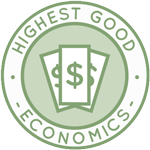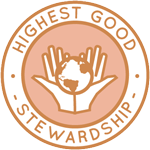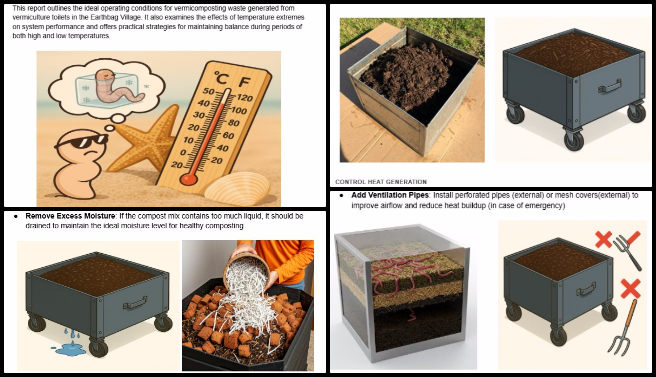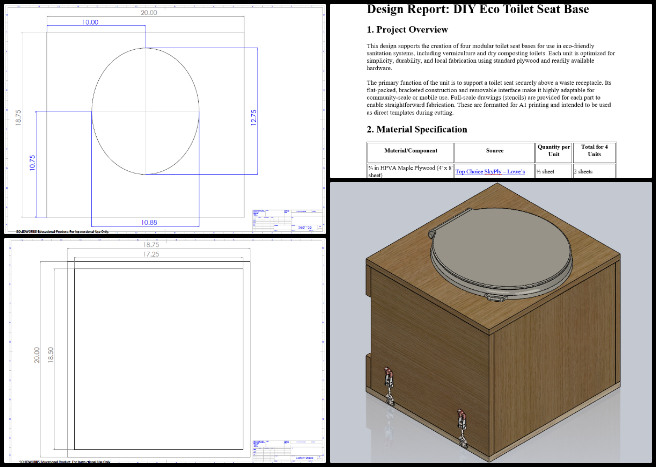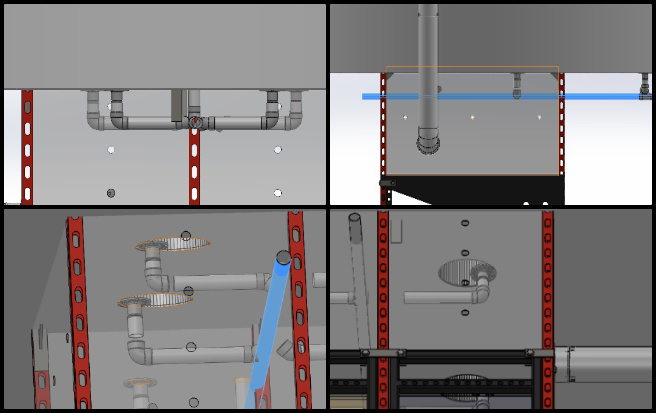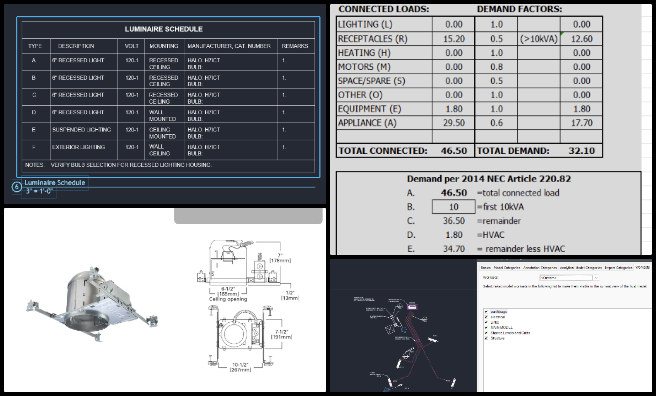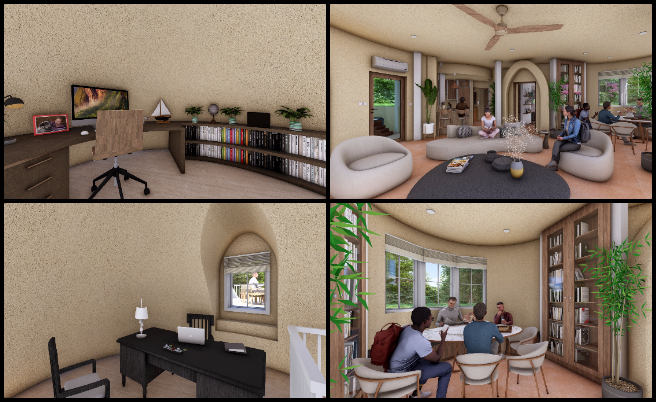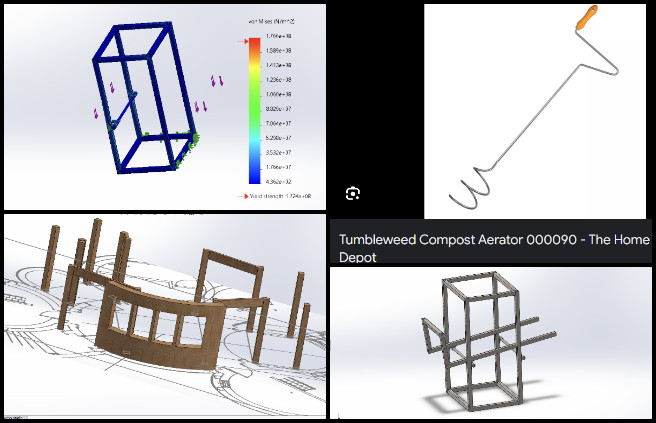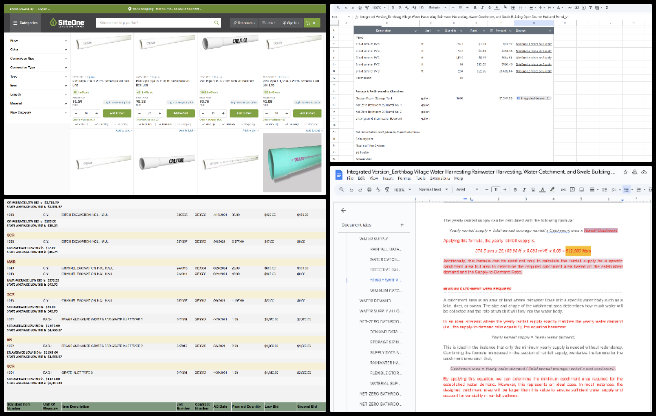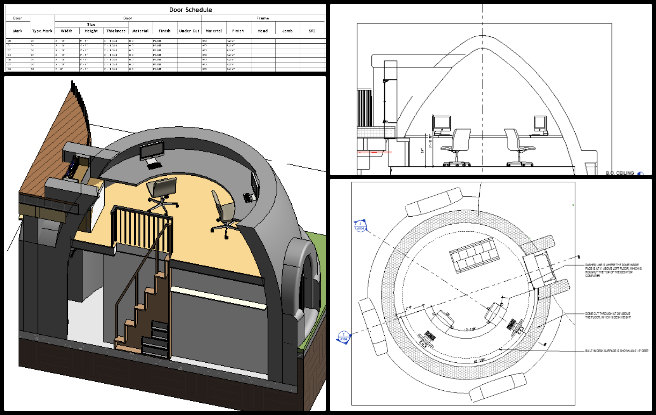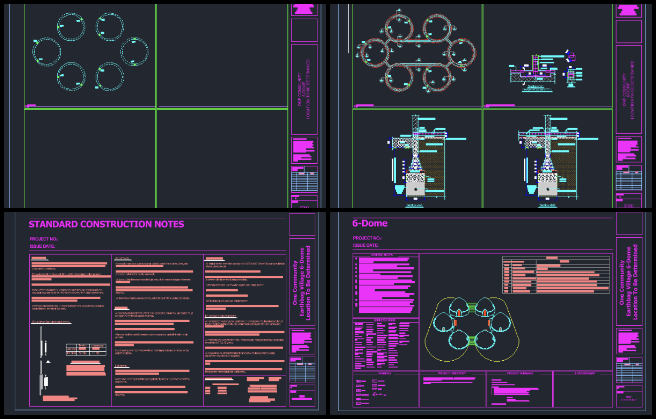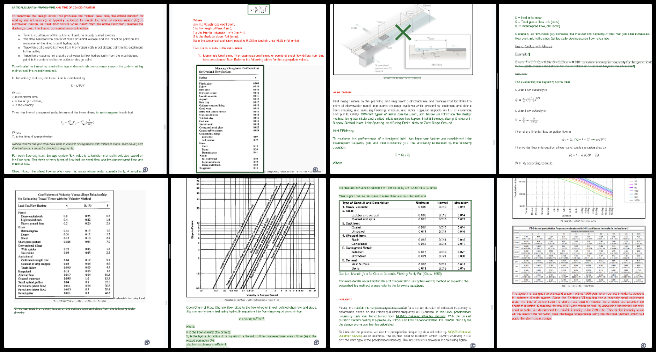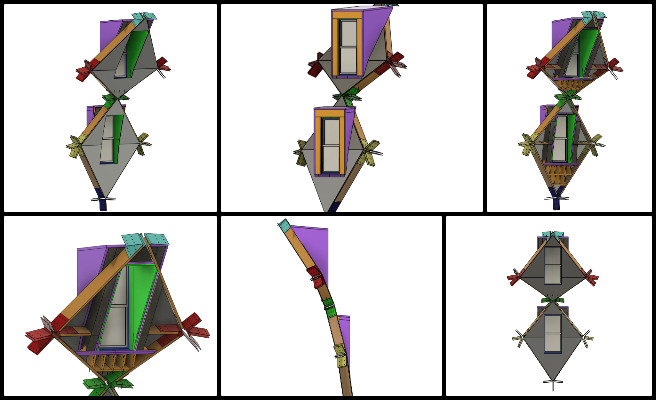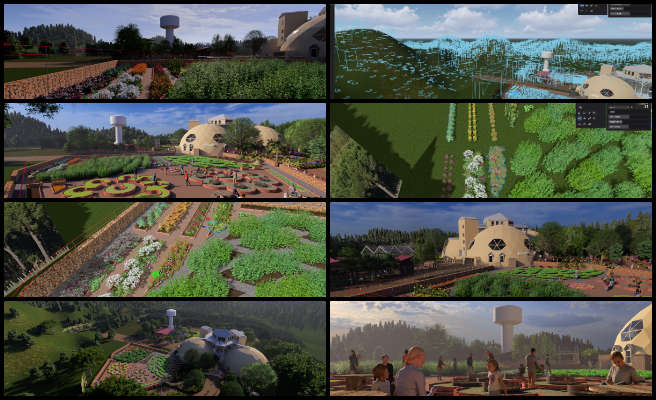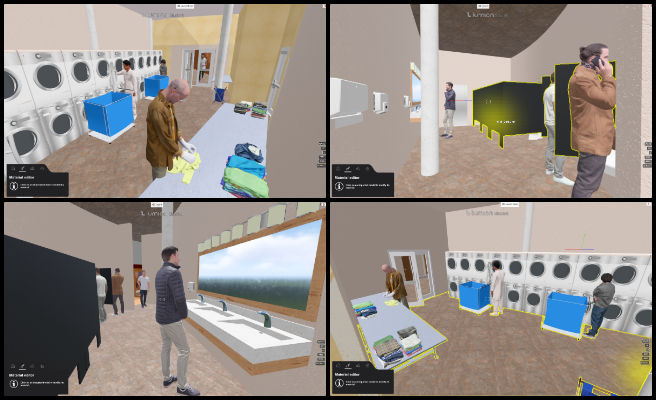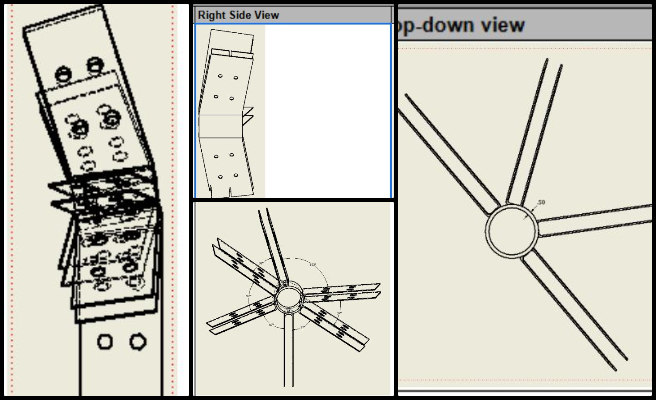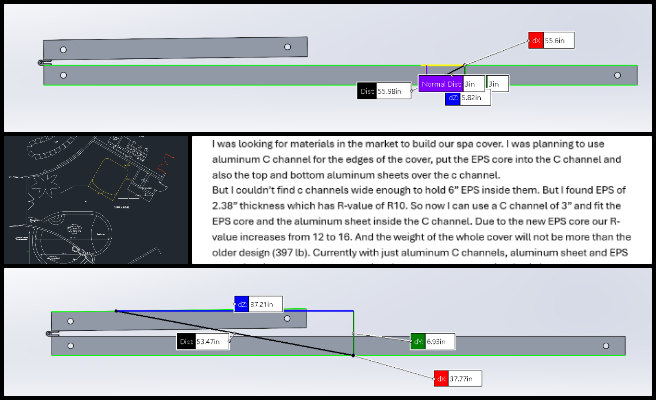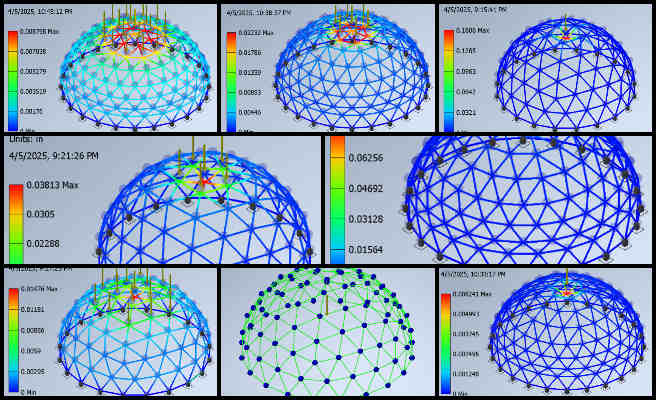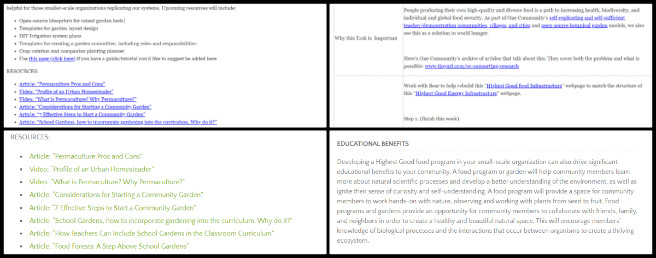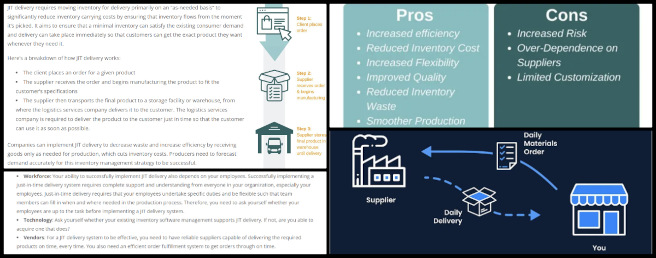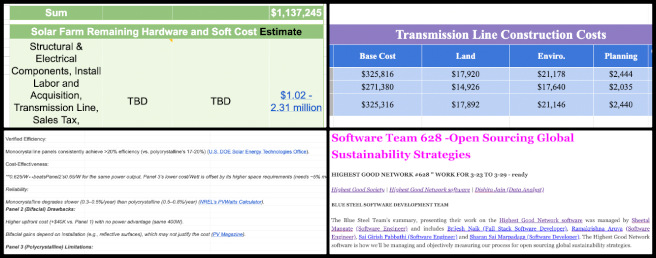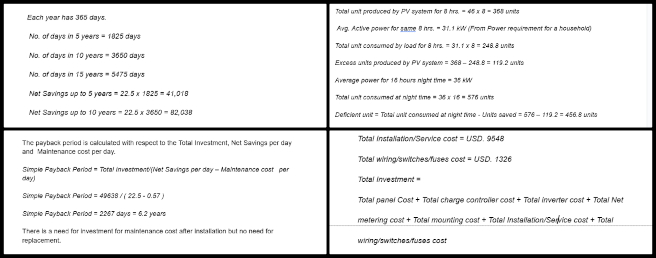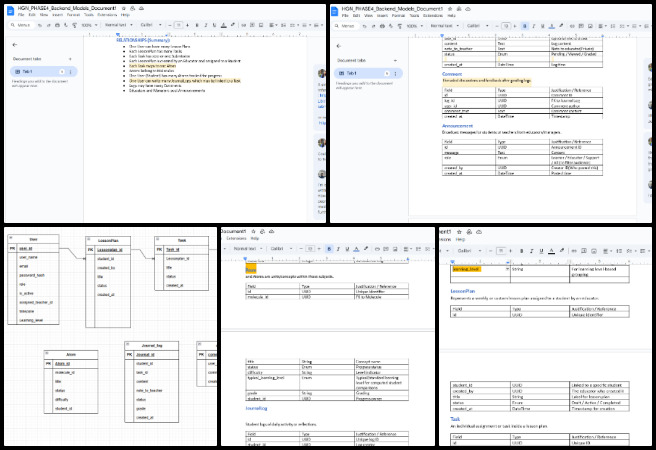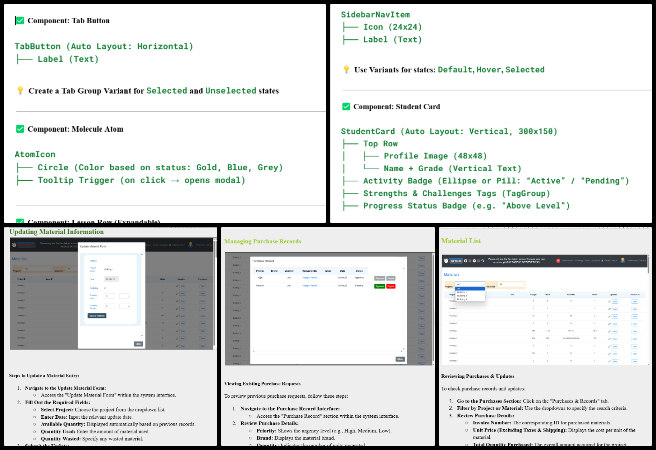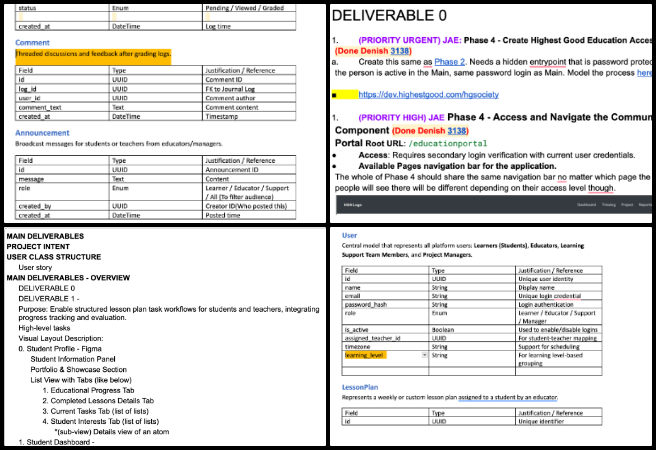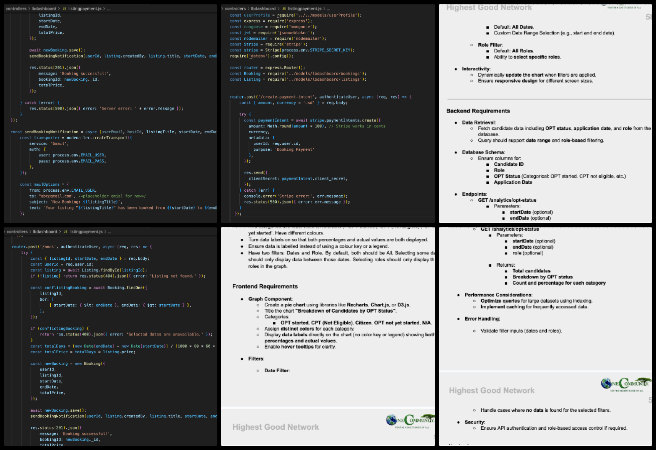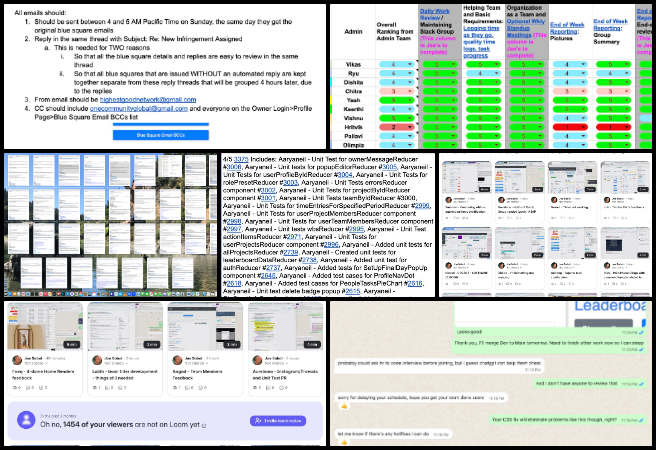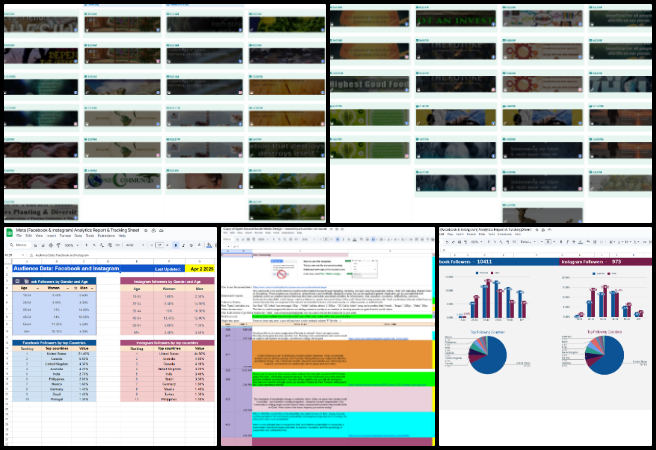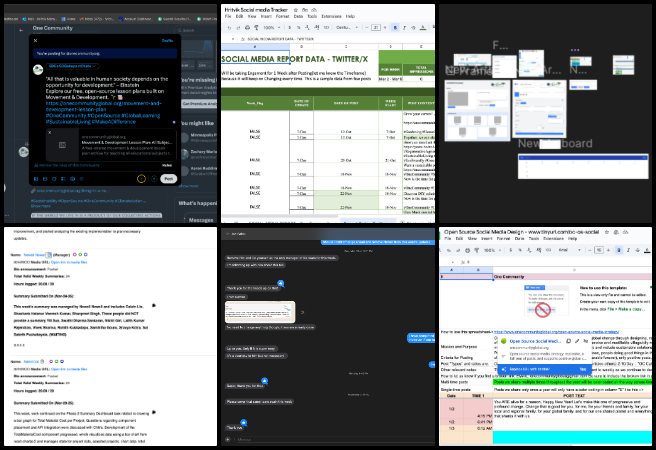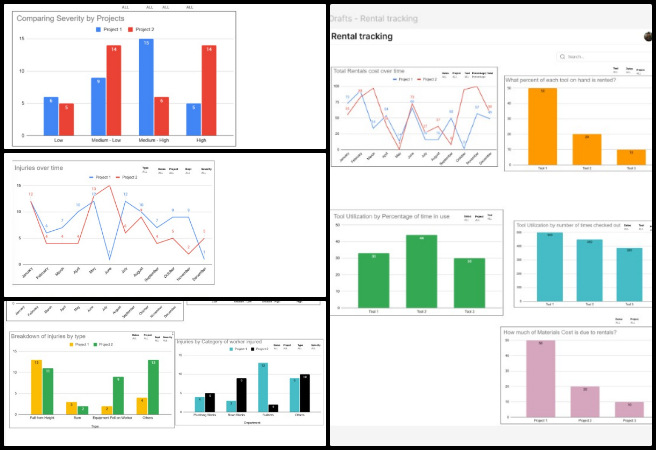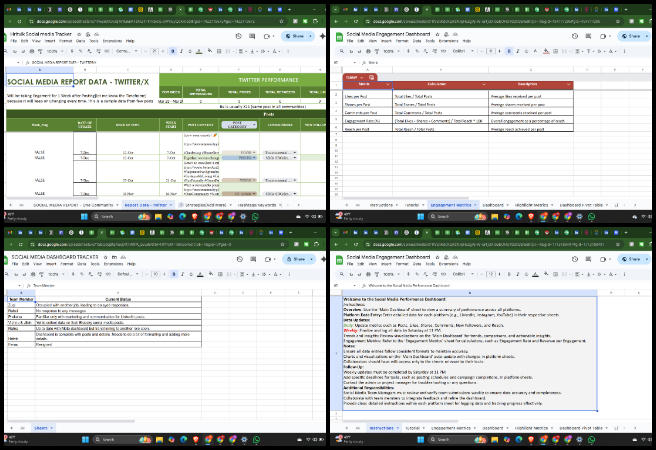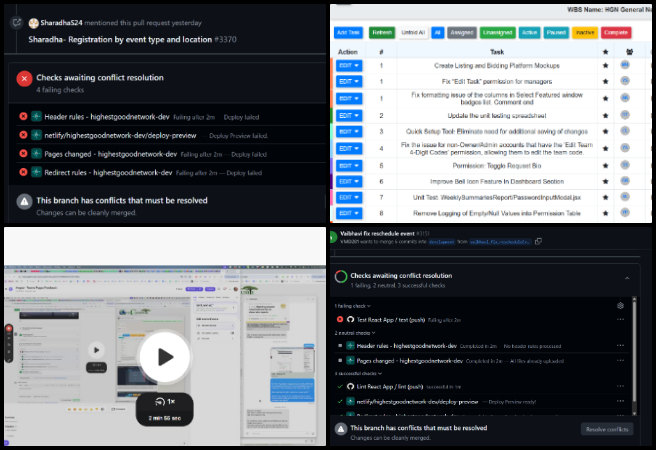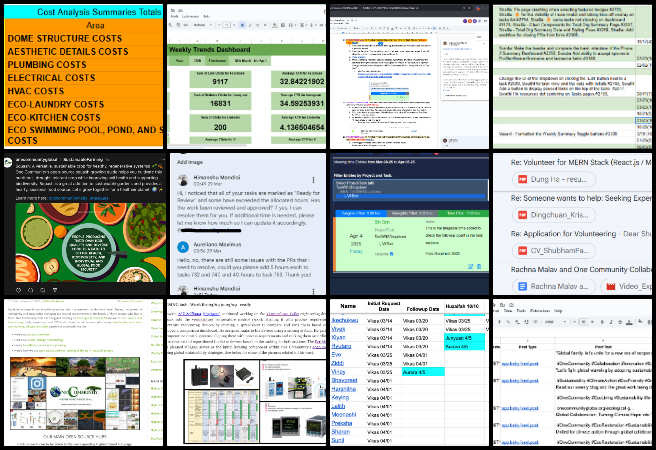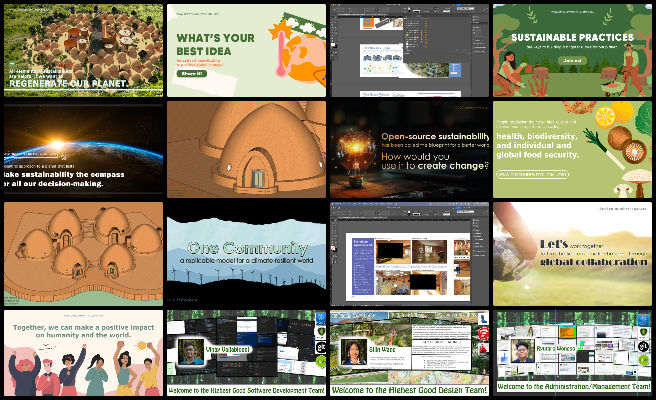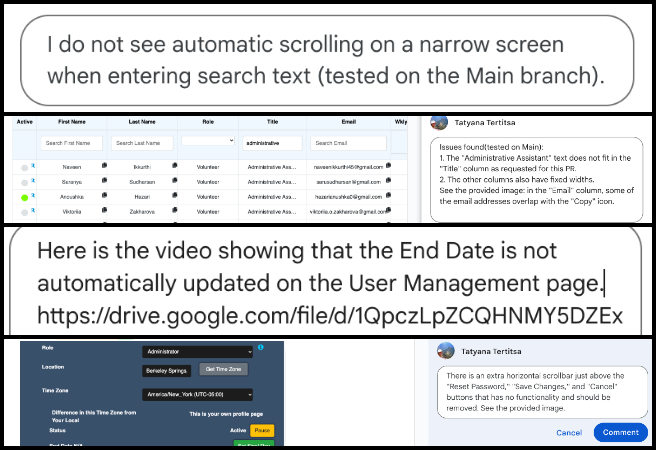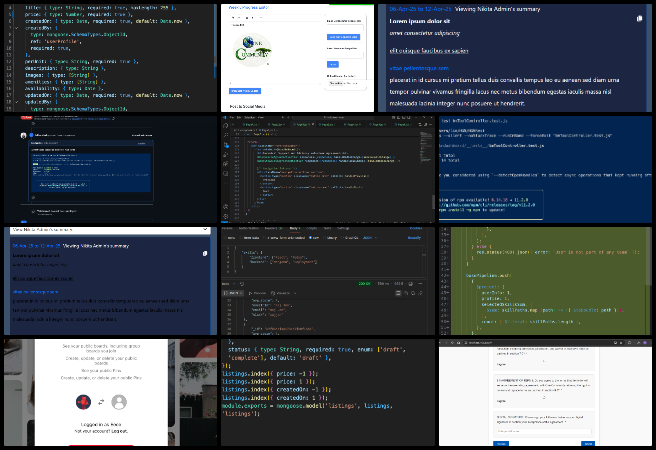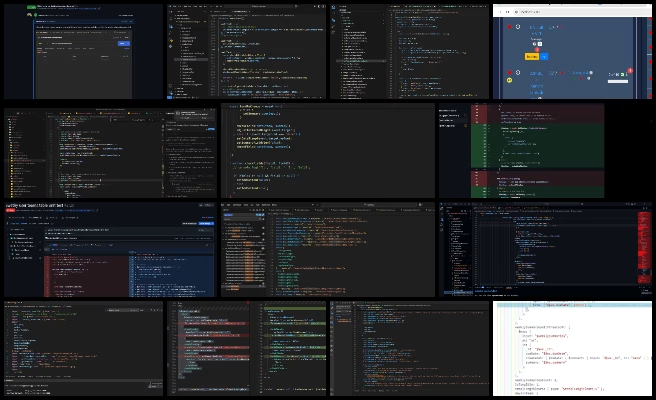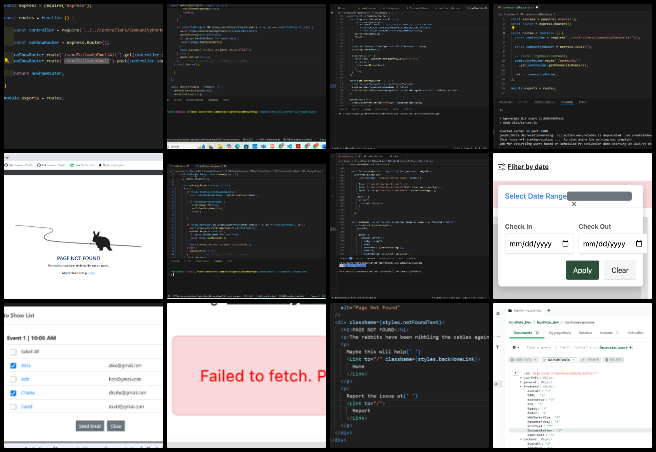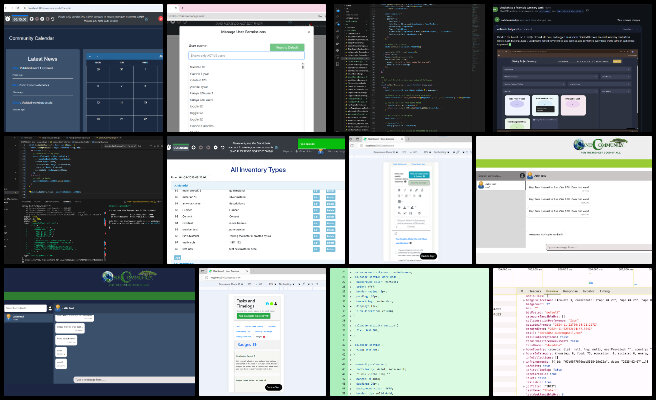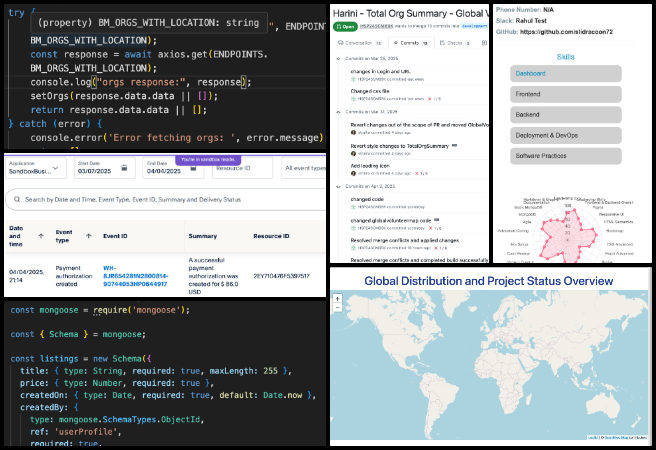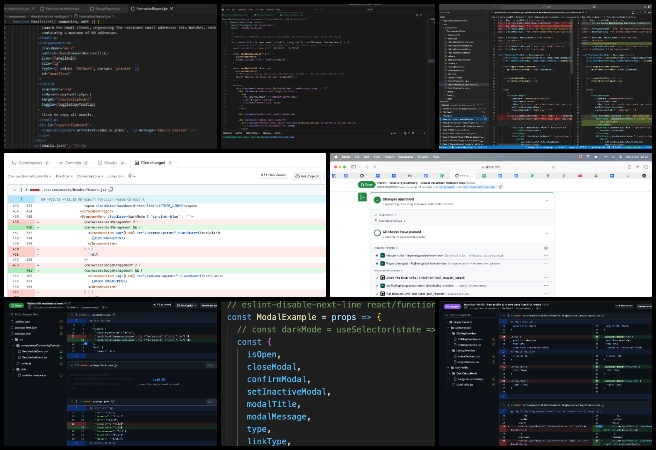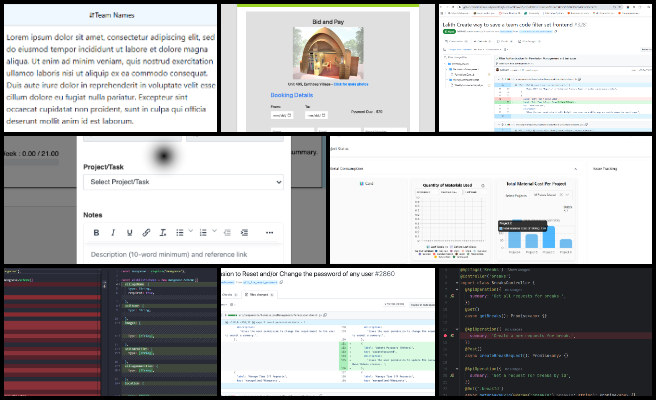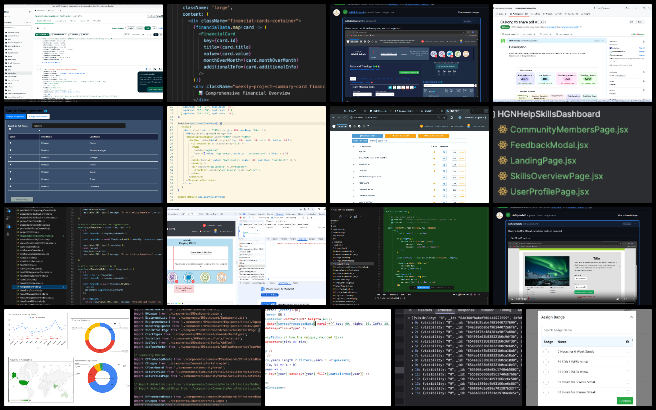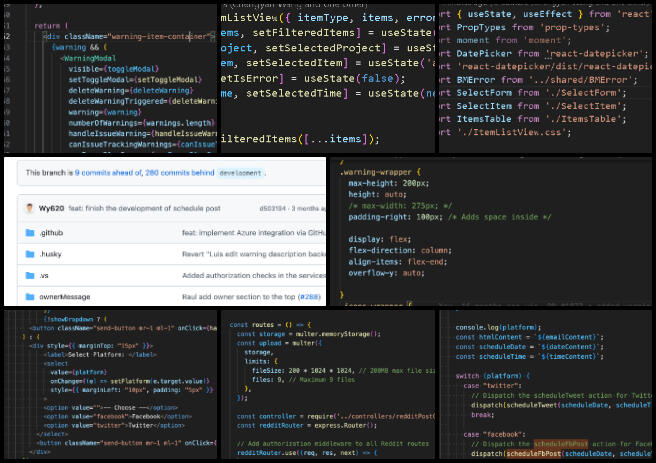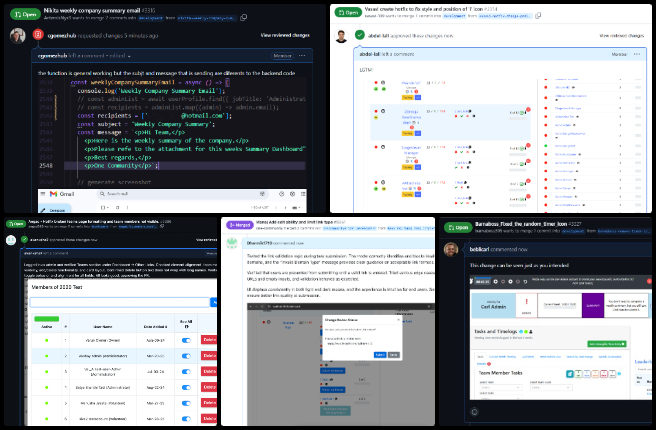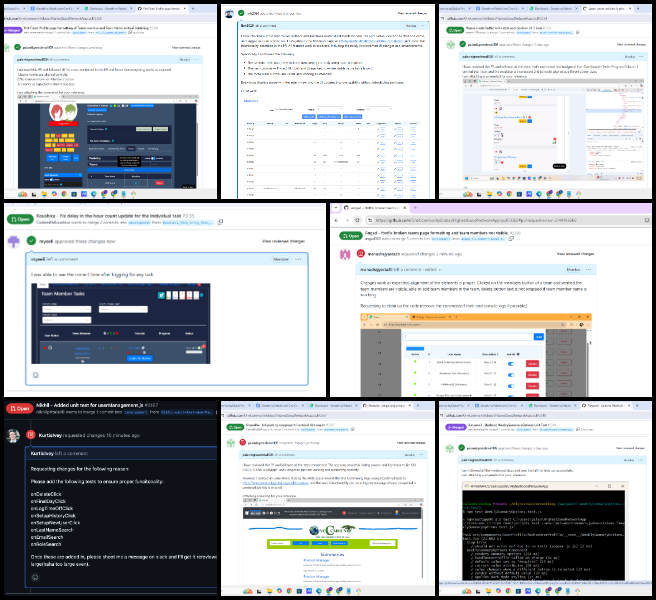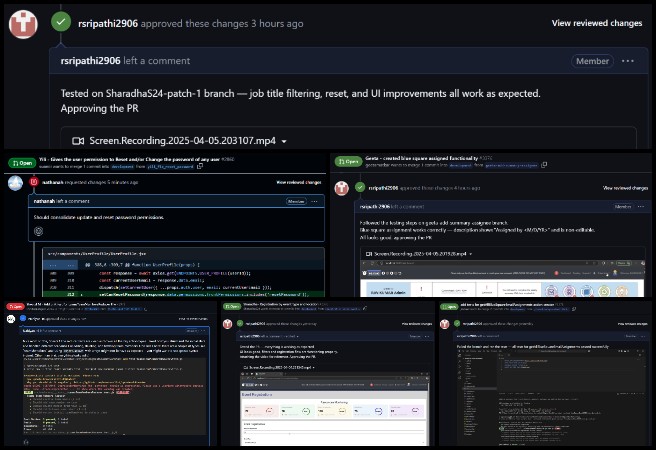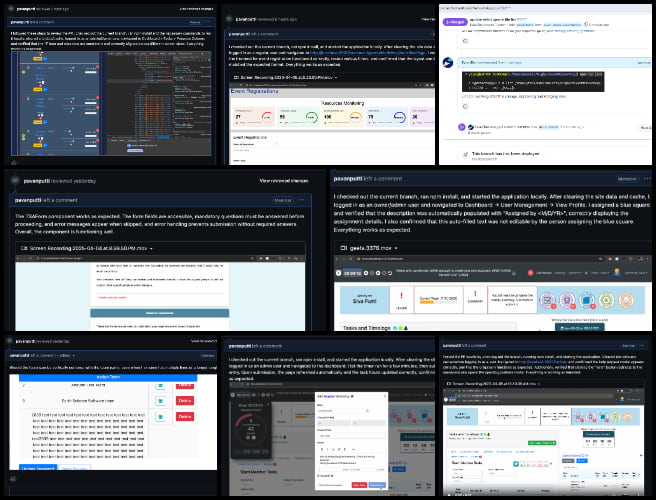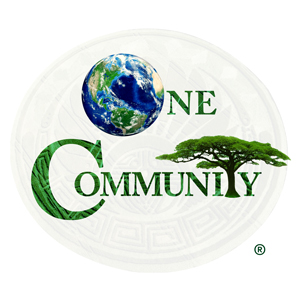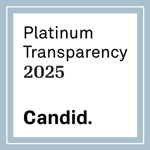Community Conservation through Diversification – One Community Weekly Progress Update #629
Community conservation through diversification is at the heart of our all-volunteer organization. Through sustainable approaches to food, energy, housing, education, for-profit and non-profit economic design, social architecture, fulfilled living, global stewardship practices, and more, One Community is creating a model designed to be self-replicating. By designing everything as open source and free-shared, we ensure accessibility and inspire collective growth. With a focus on evolving sustainability, we are dedicated to creating a world that works for everyone while regenerating our planet. This model will serve as the foundation for a global collaboration of teacher/demonstration hubs, all done in the pursuit of “The Highest Good of All“.
- Here’s our project overview
- Here’s our world-change methodology
- Here’s how this becomes self-replicating
- Here’s how we are open source and free-sharing all the do-it-yourself designs

OUR MAIN OPEN SOURCE HUBS
Click on each icon to be taken to the corresponding Highest Good hub page.
One Community’s physical location will forward this movement of community conservation through diversification as the first of many self-replicating teacher/demonstration communities, villages, and cities to be built globally. This is the April 7th, 2025 edition (#629) of our weekly progress update detailing our team’s development and accomplishments:
Community Conservation through Diversification
One Community Progress Update #629
DONATE | COLLABORATE | HELP WITH LARGE-SCALE FUNDING
CLICK HERE IF YOU’D LIKE TO RECEIVE AN EMAIL EACH WEEK WHEN WE RELEASE A NEW UPDATE
YOU CAN ALSO JOIN US THROUGH SOCIAL MEDIA
ONE COMMUNITY WEEKLY UPDATE DETAILS
HIGHEST GOOD HOUSING PROGRESS
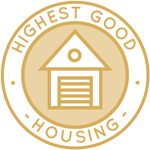 One Community is creating community conservation through diversification through Highest Good housing that is artistic and beautiful, more affordable, more space efficient, lasts longer, DIY buildable, and constructed with healthy and sustainable materials:
One Community is creating community conservation through diversification through Highest Good housing that is artistic and beautiful, more affordable, more space efficient, lasts longer, DIY buildable, and constructed with healthy and sustainable materials:
- Learn about: Our Upcoming Crowdfunding Campaign
- Learn about the different village models: 7 Sustainable Village Models
- Visit the open source portals for the first two: Earthbag Village OS Hub | Straw Bale Village OS Hub
This week, Adil Zulfiquar (Engineer) continued working on the Vermiculture Toilet engineering designs. Adil updated the vermiculture operating conditions and schedule report, incorporating feedback from the review. The contents were streamlined to better reflect the actual operating conditions and procedures of the vermiculture system, including worm addition, bedding material, ventilation, moisture levels, and standard operating procedures. Extreme condition procedures were revised, and new images were added while existing images were updated to ensure they were royalty-free. The Earthbag Village, the first of seven planned villages, serves as the initial housing component within One Community’s open source model for community conservation through diversification. See below for some of the pictures related to this work.
Anil Karathra (Mechanical Engineer) continued advancing the engineering and design of the Vermiculture Toilet for the Earthbag Village project. The second round of feedback from Jae was received regarding the toilet seat lockdown mechanism, and work continued on finalizing the design and CAD model. The CAD for the mechanism was completed, and efforts shifted to preparing the associated documentation. A digital mockup of the DIY toilet seat was created, along with engineering drawings and part stencils to support fabrication. Work progressed on the design report and the preliminary bill of materials for the eco toilet seat. A weekly summary was compiled, and screenshots of the previous week’s work were uploaded to Dropbox. This commitment to community conservation through diversification drives the development of innovative, eco-friendly solutions that balance environmental responsibility with high standards of functionality. See below for pictures related to this work.
Audrey Gunawan (Mechanical Engineer) continued working on the Vermiculture Toilet plumbing details. Audrey continued work on the SolidWorks model, testing different configurations after identifying that the main plumbing line was interfering with the rail for the compost box. She modeled the pipes and attempted to lengthen one side but determined that additional revisions would be needed to refine the design. Her time was spent evaluating whether to lengthen sections or introduce bends in the model and assessing the feasibility of these adjustments within general plumbing practices. To support this evaluation, she reviewed plumbing codes and examples for reference. The model also presented mating errors in SolidWorks, which added difficulty to the process. As the first of seven planned villages, Earthbag Village provides the initial housing within One Community’s open source designs for community conservation through diversification. See below for some of the pictures related to this work.
Derrell Brown (Plumbing Designer) continued working on the Earthbag Village 4-dome home plumbing details. Derrell coordinated with Michaela on Monday to address minor follow-up items related to the 75% coordination electrical set previously submitted for review, including the addition of schedules and supporting information. He reviewed past documents to gather lighting fixture data, such as bulb types and housing, and used this information to create a luminaire schedule. Referencing material from the One Community website, he developed the luminaire schedule for inclusion in the architectural switching plan. After preparing this schedule for review, Derrell worked on remaining mechanical and plumbing tasks, which included relocating the condensate drain from the ductless fan coil unit to avoid it penetrating through the middle of the ceiling, adjusting vent stacks to resolve clashes, and creating an additional floor plan in Revit to address visibility graphics issues in the HVAC plan. One Community’s open source launching of community conservation through diversification begins with Earthbag Village, the first of seven planned villages providing housing. See below for some of the pictures related to this work.
Faeq Abu Alia (Architectural Engineer) continued his work on the Earthbag Village 4-dome home renders. Faeq worked on rendering the walkthrough video to visually present the updated design and enhancements of the 4-dome home. The focus was on refining the interior by adding blinds, decorative elements, and applying double-layered materials to improve visual appeal and ensure design cohesion. These updates were implemented to align with the overall layout and style of the structure, maintaining consistency across all spaces. The Earthbag Village is the first of 7 to be built as the housing component of One Community’s open source plans for community conservation through diversification. View examples of this work in the pictures provided below.
Karthik Pillai (Mechanical Engineer) continued helping finish the Vermiculture Toilet engineering and helping with the Earthbag Village 4-dome home roof plan. Karthik resumed work on both projects following a two-week break. For the 4-dome cluster roof design, with the roof structure now nearly finalized, he began drafting the report to document all findings and progress to date. During a meeting with Michaela, additional action items were identified, including the need for a Finite Element Analysis of the window beams, which will be addressed later. On the Vermiculture toilet design, he continued progress on the waste dumping mechanism report, and the design for the main Unistrut system is close to completion. As the first of seven planned villages, Earthbag Village provides the initial housing within One Community’s open source designs for community conservation through diversification. See the work in the collage below.
Ketsia Kayembe (Civil Engineer) started working on the Earthbag Village designs related to Rainwater Harvesting and Water Catchment. Ketsia completed the orientation and read background materials on the Earthbag Village project before reviewing the updated stormwater management and rainwater harvesting designs prepared by Yi-Ju. She corrected spelling and grammar issues in the documentation and verified calculations related to the design. Ketsia contacted Yi-Ju to arrange a meeting to clarify project tasks and discuss outstanding questions and coordinate next steps. She began working on the cost analysis by estimating expenses based on Yi-Ju’s design, compiling a list of required materials, and researching vendors to identify affordable pricing options. One Community’s open source model for community conservation through diversification begins with Earthbag Village, the first of seven planned villages providing housing. See below for some of the pictures related to this work.
Michaela Silva (Architect) continued working on the architectural details for the Earthbag Village 4-dome home design. Michaela modeled a desk for the primary bedroom loft office and drew sections through the computer to confirm that the desk’s depth aligns with the curvature of the dome. She also continued work on the door sheet by creating a door schedule and tagging the doors in the floor plan. As the first of seven villages in One Community’s open source plan for community conservation through diversification, the Earthbag Village represents the housing element. See her work in the collage below.
Rumi Shah (Civil Engineer) continued working on the Earthbag Village upgrades to bring our designs closer to construction-ready plans. Rumi worked on refining the construction notes and cover sheet to ensure all critical details were included for the project’s progression. Rumi also reviewed technical specifications and made adjustments to optimize the foundation details. Work continued on the calculations and design of the dome structure, which involves complex engineering requirements. The drafting of the dome design is in progress, with plans to submit the finalized documents. One Community’s open source resources for community conservation through diversification begin with the Earthbag Village, the first of seven planned villages providing housing. See below for some of the pictures related to this work.
Yi-Ju Lien (Environmental Engineer) continued her work on the Earthbag Village LEED points related to stormwater retention. Yi-Ju worked on updating the webpage content for the stormwater drainage system design methodology. She revised the section on the rational method for calculating peak discharge by adding more detail on critical duration and time of concentration, and explaining the use of the velocity method to calculate this time. She introduced three flow types—sheet flow, shallow concentrated flow, and open channel flow—along with their respective calculation methods. In the roadway drainage design section, Yi-Ju focused on gutter flow analysis and inlet design, adding information to clarify the use of equations and noting that discharge calculations for gutter analysis vary depending on the gutter section type. She also specified that different charts or equations are required for different configurations, highlighting the importance of maintaining collaboration and unity in community conservation through diversification. See some of the work done in the collage below.
DUPLICABLE CITY CENTER PROGRESS
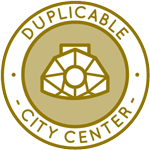 One Community is creating community conservation through diversification through a Duplicable and Sustainable City Center that is LEED Platinum certified/Sustainable, can feed 200 people at a time, provide laundry for over 300 people, is beautiful, spacious, and saves resources, money, and space:
One Community is creating community conservation through diversification through a Duplicable and Sustainable City Center that is LEED Platinum certified/Sustainable, can feed 200 people at a time, provide laundry for over 300 people, is beautiful, spacious, and saves resources, money, and space:
- Learn about this building and it’s function: Duplicable City Center Open Source Hub
This week, Andrew Chen (Industrial Designer) continued working on the Dormer second-floor window for the Duplicable City Center. He researched the Singapore Jewel, focusing on its spherical architecture and diamond structural framework, to explore how the window could integrate with similar architectural features. Andrew completed the first full model of the second-floor window, which included the internal structure and insulation. He is now waiting for feedback to move forward with the next stage of development. The Duplicable City Center is a foundational part of One Community’s open-source model, contributing to community conservation through diversification. See some of this work in the pictures below.
Jason Bao (Architectural Designer) continued working on producing renders for the Duplicable City Center library. His communication with Jae clarified next steps, and updated components from Nimika were shared with Yan. Adjustments to the garden area were implemented based on Jae’s instructions, including the addition and removal of plants, people, and other models. Rendering parameters were modified to align with project goals, and surrounding terrain elements were incorporated to enhance scene context. File optimizations were prioritized to maintain workflow efficiency while integrating updates. One Community’s open-source model features the Duplicable City Center, which plays a vital role in community conservation through diversification. See the work in the images below.
Mohammed Maaz Siddiqui (Architect) wrapped up his work on the interior renders for the Duplicable City Center project. The furniture in the older scenes was adjusted to ensure all pieces were properly placed on the ground, and a few plants were added to the outdoor area to enhance its appearance. The overall scenes of the laundry room and washroom were developed by searching for and updating materials and finishes to align with the project color palette based on the reference file provided by Jae. The scenes were then updated with appropriate 3D models to improve realism. The Duplicable City Center is an essential part of One Community’s open-source approach, aiding in community conservation through diversification. Explore the work in the pictures below.
Manjiri Patil (Mechanical Design Engineer) continued working on the designs for the City Center Dome Hub Connector Engineering. She is currently working on the review feedback provided by Jae and making the necessary updates to the manufacturing process report and excel sheet. In parallel, she is also refining the CAD drawing, addressing some gaps that were previously identified. One Community’s open-source Duplicable City Center is a key part for the community conservation through diversification. The images below showcase some of this work.
Sanket Basannavar (Mechanical Engineer) continued working on the Duplicable City Center spa cover as part of the City Center Natural Pool and Eco-spa Designs. A SolidWorks model was created for the walls and mechanical room, and it was assembled with the spa and spa cover. A mechanism was designed to hold the motor that will rotate the pulley to open the spa cover. The AutoCAD plan was revised by removing the space previously designated for the waterfall and reallocating the space for additional features like chairs and tables. As a foundational component of One Community’s open-source model, the Duplicable City Center promotes community conservation through diversification. See examples in the images below.
Shu-Tsun (Engineer) continued working on the City Center Dome Hub Connector Engineering by conducting the structural and frame analysis of the City Center dome using Autodesk Inventor, as well as working on the spreadsheet for which she is responsible. She reviewed her earlier analysis and discovered several errors that had impacted the accuracy of her findings. To address this, she chose to start the analysis over from scratch to ensure everything was handled properly. Shu-Tsun also carefully studied the instruction manual and related documentation to deepen her understanding of the correct procedures. Her goal was to prevent similar mistakes in the future and enhance the overall quality of her work. The Duplicable City Center is a key element of One Community’s open-source model, supporting community conservation through diversification. Check out some of the work in the images below.
Srujan Pandya (Mechanical Engineer) continued helping with the City Center Dome Hub Connector Engineering analysis. He worked on the previous traditional dome design and the City Center dome design to ensure a consistent model setup across both. This included applying fixed constraints on the last row, using the same previously defined load cases, and implementing frame analysis using simplified beam and node representations. The results for all three versions, version 0 (traditional dome), version 1 (city center dome), and version 2 (modified city center dome) were updated in the spreadsheet, along with notes and remarks interpreting the outcomes. One Community’s open-source model features the Duplicable City Center, which plays a vital role in community conservation through diversification. See the work in the images below.
HIGHEST GOOD FOOD PROGRESS
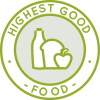 One Community is creating community conservation through diversification through Highest Good food that is more diverse, more nutritious, locally grown and sustainable, and part of our open source botanical garden model to support and share bio-diversity:
One Community is creating community conservation through diversification through Highest Good food that is more diverse, more nutritious, locally grown and sustainable, and part of our open source botanical garden model to support and share bio-diversity:
- Learn about the structures: Hoop House Hub | Aquapini & Walipini Open Source Hub
- See what we’ll be growing: Gardens & Hoop Houses | Large-scale Structures | Food Forest | TA
This week, the core team completed adding photos to the Master Tools, Equipment, and Materials/Supplies document, including items related to the Goat, Chicken, and Rabbit sections. They also made sure that duplicate entries were removed and additional items were incorporated into both the master document and the hoop house listing. Certain additions, while not directly related to construction, pertain to ground preparation, ongoing operation, and maintenance. These items were designated with an asterisk to differentiate them from construction-specific tools and supplies. The Highest Good Food initiative is a key component of One Community’s open source plans, focused on community conservation through diversification, and exemplifies the organization’s commitment through innovative design and implementation. Below are some of the images showcasing this work.
Dirgh Patel (Volunteer Mechanical Engineer) continued assisting with the Climate Battery design evolutions. He reviewed CAD models related to the piping system and its connection to the climate battery, including joints, assemblies, and dimensions. He created detailed drawings in SolidWorks, verified dimensions against provided theory, exported them as standard PDFs, created a motion assembly, and saved both exploded and rotational views. Dirgh also began simulation work focused on the stress, strain, and deformation of pipes under the calculated weight of overlying dirt. He worked on FEA analysis, starting with individual components and then the full assembly, using estimated dirt volume to determine load and assess resulting pipe deformation. The Highest Good Food initiative is a key component of One Community’s open source plans, focused on community conservation through diversification, and exemplifies the organization’s commitment through innovative design and implementation. Below are some of the images showcasing his work.
Jay Nair (BIM Designer) continued working on Aquapini and Walipini Planting and Harvesting lighting and HVAC design. He held a call with a team member to discuss an alternative design for Walipini 1 that includes earthen roofs. Additionally, Jay continued working on the lighting energy calculations to reflect the changes in the roof design and continued researching how to use Dynamo for Revit to develop the corresponding lighting fixture. The Highest Good Food initiative is a key component of One Community’s open source plans, focused on community conservation through diversification, and exemplifies the organization’s commitment through innovative design and implementation. Below are some of the images showcasing this work.
Keerthi Reddy Gavinolla (Software Developer) continued working on the Highest Good Food page additions covering small-business and urban community options. She reviewed the Expressers team’s work, created their team collage, commented on their documents, and updated Blog #628. She also updated the Vermiculture website by adding additional provided content and started contributing to the Highest Good Food Infrastructure website. Additionally, she focused on editing formatting, adjusting headings, and justifying text to ensure consistency and readability. The Highest Good Food initiative is essential to One Community’s open source plans, focused on community conservation through diversification, and exemplifies the organization’s commitment through innovative design and implementation. Her contributions are highlighted in the collage below.
Mary Nelson (Landscape Planner) continued research and development of various Highest Good Food components. This week’s focus was research for community conservation through diversification by focusing primarily on editing the soil amendments strategy and making several updates to the document’s format to align with One Community standards. She continued working on the botanical garden tutorial, confirming that the correct page had been edited and was in the proper format. She requested time to meet for a review of her work in preparation for publishing. Additionally, she completed the meadow garden maintenance program she had started the previous week. The Highest Good Food initiative is essential to One Community’s open source plans, focused on community conservation through diversification, and exemplifies the organization’s commitment through innovative design and implementation. Her contributions are highlighted in the collage below.
Tanmay Koparde (Industrial Engineer and Team Administrator) continued optimizing the Food Procurement and Storage Plan to enhance efficiency and sustainability. He continued leveraging the Just-In-Time (JIT) methodology to enhance food storage efficiency and mitigate supply chain disruptions using the NetSuite ERP software. He explored approaches to address inventory shortages and ensure smooth food distribution. Additionally, he studied the concept of buffer stock and explored how to effectively implement it within food storage systems using the NetSuite ERP, focusing on strategies to prevent spoilage and minimize waste while maintaining sufficient reserves for emergency situations. The Highest Good Food Initiative is a key component of One Community’s open source plans, focused on community conservation through diversification, and exemplifies the organization’s commitment through innovative design and implementation. See his work in the collage below.
HIGHEST GOOD ENERGY PROGRESS
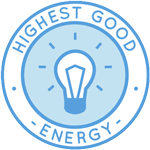 One Community is creating community conservation through diversification through Highest Good energy that is more sustainable, resilient, supports self-sufficiency and includes solar, wind, hydro and more:
One Community is creating community conservation through diversification through Highest Good energy that is more sustainable, resilient, supports self-sufficiency and includes solar, wind, hydro and more:
- Learn about the open source sustainable-energy foundations: Solar, Hydro, and Wind
- Explore our research into the most sustainable products and companies for saving water and energy: Insulation, Eco-laundry, Lightbulbs and Light Bulb Companies, Doors and Door Companies, Windows and Window Companies, Toilets, Faucets and Faucet Accessories, Urinals, and more.
This week, Dishita Jain (Data Analyst) continued assisting with the Highest Good Energy research and cost analysis for community conservation through diversification. She made updates to the spreadsheet with new resources, incorporating feedback provided by Jae and addressing additional issues identified during the review process. Prior to that, relevant research was completed, and initial data updates were shared for evaluation. Additionally, work was done on OC Administration activities, including reviewing and providing feedback on other admins’ blogs and images, as well as working on the training team’s review and creating a blog post with a summary and collage. The Highest Good Energy initiative is a key component of One Community’s open source plans, focused on community conservation through diversification, and exemplifies the organization’s commitment through innovative design and implementation. Below are some of the images showcasing this work.
Muhammad Sarmad Tariq (Electrical Engineer) continued assisting with off-grid and grid-tied Solar Microgrid comparisons as part of the Highest Good Energy component. This is part of research for community conservation through diversification covering sustainable power supply. This week’s focus was working on a report describing the calculator used to determine profit and net savings for both off-grid and grid-tied solar PV systems. He focused on the net savings and economic analysis of the on-grid PV system. In response to feedback from Jae on the final version of the Off-Grid vs. On-Grid PV system report, he reviewed relevant research and explored options for incorporating PV system sizing into the report. The Highest Good Energy initiative is a key component of One Community’s open-source plans, focused on community conservation through diversification, and exemplifies the organization’s commitment through innovative design and implementation. See his work in the collage below.
HIGHEST GOOD EDUCATION PROGRESS
 One Community is creating community conservation through diversification through Highest Good education that is for all ages, applicable in any environment, adaptable to individual needs, far exceeds traditional education standards, and more fun for both the teachers and the students. This component of One Community is about 95% complete with only the Open Source School Licensing and Ultimate Classroom construction and assembly details remaining to be finished. We’ll report on the final two elements to be finished as we develop them. With over 8 years of work invested in the process, the sections below are all complete until we move onto the property and continue the development and open sourcing process with teachers and students – a development process that is built directly into the structure of the education program and everything else we’re creating too:
One Community is creating community conservation through diversification through Highest Good education that is for all ages, applicable in any environment, adaptable to individual needs, far exceeds traditional education standards, and more fun for both the teachers and the students. This component of One Community is about 95% complete with only the Open Source School Licensing and Ultimate Classroom construction and assembly details remaining to be finished. We’ll report on the final two elements to be finished as we develop them. With over 8 years of work invested in the process, the sections below are all complete until we move onto the property and continue the development and open sourcing process with teachers and students – a development process that is built directly into the structure of the education program and everything else we’re creating too:
- Program Overview: Education Open Source Hub
- How the components work together in designing human orchestrated eco-abundance: How to use the Education for Life Program
- Lesson Plans for Life – Lesson Plans How-to
- Foundations of Outstanding Leaders, Teachers, and Communicators
- Curriculum for Life
- Teaching Strategies for Life
- Learning Tools and Toys for Life
- Evaluation and Evolution
This week, Akhil Guntur (FullStack Engineer) continued his work on enhancing and refining his backend model documentation for the Highest Good Education open source software designs, carefully exploring multiple backend design approaches. He systematically reviewed his teammates’ feedback, analyzed their comments in detail, and provided detailed responses to ensure clarity and alignment. Following additional research, he updated the documentation, integrating valuable insights and suggestions from the team. To strengthen his understanding and effectively inform backend setup decisions, he extensively reviewed existing HGN websites, gathering detailed information about current backend implementations. Additionally, he focused on creating clear and efficient entity relationship diagrams based on the improved models. These diagrams are essential for visualizing backend structures, enabling a smoother transition into the development phase. The One Community model of community conservation through diversification with sustainably built classrooms like this is an excellent example of sustainable change for the whole planet. See the collage below for his work.
Chitra Siddharthan (Data Analyst and Team Administrator) continued working on the deliverables for the Highest Good Education phase 4 software. The coursework description was prepared for the wireframes. Phase 2 Slack messages, tasks, and PRs were checked to track the progress of the reviews. The ‘Teacher Dashboard’ for phase 4 was broken down and is now ready for the wireframe structure. Additionally, tasks 747 through 753 were added for phase 2. The One Community model of community conservation through diversification with sustainably built classrooms like this is an excellent example of sustainable change for the whole planet. See the collage below for her work.
Harshitha Rayapati (Program Manager) continued work on detailing deliverables for the Highest Good education software platform, outlining various components, developing Figma designs, and expanding the visual layout of the student dashboard. This week, her work focused on the action items document to support the development and design process of Phase 4. Edits and changes were made to the backend architecture design shared by Akhil, and the updated action items document was submitted for Jae’s feedback. After reviewing Jae’s input, work moved forward with implementing the suggested changes. The HGN Phase 4 document was cleaned up to remove duplicates and unnecessary details, and content from other related documents was merged into the main Phase 4 document. Specific action items were detailed for the first sprint, and steps were taken to expand the front-end team and delegate tasks to Chitra. The backend design and action items were also merged into the original design document. Additionally, Harshitha assisted in compiling the weekly blog update, reviewed the Graphic Design Team’s weekly progress, edited the blog page, and created a collage. The One Community model of community conservation through diversification with sustainably built classrooms like this is an excellent example of sustainable change for the whole planet. See the collage below for her work.
Mrinalini Raghavendran (Software Engineer) continued refining and documenting both frontend and backend requirements for various graphs. She added formatting updates to the requirements document and captured additional dashboard ideas offline. She updated the documentation and continued working on the backend Node.js code for listing payments. Throughout the week, she wrote additional code, introduced new functionalities, and organized the backend codebase into appropriate folders. Toward the end of the week, she worked on integrating the Stripe payment intent functionality, which is pending local testing. By forwarding community conservation through diversification with classrooms like this, One Community provides a replicable example for global sustainable development. See the collage below for her work.
HIGHEST GOOD SOCIETY PROGRESS
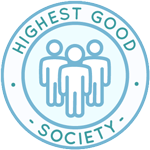 One Community is creating community conservation through diversification through a Highest Good society approach to living that is founded on fulfilled living, the study of meeting human needs, Community, and making a difference in the world:
One Community is creating community conservation through diversification through a Highest Good society approach to living that is founded on fulfilled living, the study of meeting human needs, Community, and making a difference in the world:
- Read the Highest Good society overview: Highest Good Society
- Learn about the model for fulfilled living and sharing: A Day in the Life
- Learn about the 4 economic models: RBE | For-profit | Non-profit | Entrepreneurship
- Learn about our open source community collaboration and management software: The Highest Good Network
This week, the core team completed over 48 hours managing One Community’s volunteer-work review not included above, emails, social media accounts, web development, new bug identification and bug-fix integration for the Highest Good Network software, and interviewing and getting set up new volunteer team members. They also shot and incorporated the video above that talks about how community conservation through diversification is a foundation of the bigger picture of everything One Community is doing. The image below shows some of this work.
Govind Sajithkumar (Project Manager) continued focusing on Meta platform analytics and content management for Facebook and Instagram channels. He updated the social media analytics spreadsheet with current performance metrics and processed new audience data for both platforms to ensure up-to-date reporting. He cleaned and normalized social data prior to integration into tracking systems and updated the master spreadsheet with revised audience demographics and engagement figures. He maintained scheduled content publishing on both platforms, aligning post times with audience activity patterns. He documented all new content in the Open Source spreadsheet, including relevant metadata, and kept tracking files updated to support content analytics. As part of PR Review Team Management, he provided comments and feedback on team documents, updated his WordPress site with the latest team summary and collage, revised the PR Review Team Table with required entries, and reviewed blog sites maintained by fellow admins. This work helps One Community’s mission of community conservation through diversification. The following images show his work for the week.
Hritvik Mahajan (Data Analyst) continued focusing on marketing and administrative tasks. He worked on multiple projects, including software testing, marketing, and administration. He reviewed several pull requests and communicated with team members via Slack to address merge conflicts and requested changes. He also refined the design of the HGN Social Media Scheduler. In marketing and promotion, he posted high-engagement content to Twitter communities to increase visibility and engagement. Additionally, he supported the OC Administration team by covering tasks for the moonfall team in Shrinivas’s absence and waited for feedback from Newell, as requested by Jae. This work helps One Community’s mission of community conservation through diversification. The following images show his work for the week.
Jaiwanth Reddy Adavalli (Project Manager) continued developing the Job Applicants page and the Highest Good Network Phase 2 Dashboard, making changes to better integrate these pages with existing content and data. Two pages worth of new components were created to enhance functionality, and action items were documented for further work. As part of the PR review team, he reviewed the pull requests of the volunteer team assigned to him. This work helps One Community’s mission of community conservation through diversification. The following images show his work for the week.
Raghav Dinesh Pamuru (Product Manager) continued work on coordinating with cross-functional teams to update the project roadmap and ensuring that all development tasks aligned with weekly goals. He reviewed submitted feature requests, refined backlog items in Jira, and clarified acceptance criteria in collaboration with stakeholders. He participated in daily stand-ups to provide project updates and flag blockers. He also worked with the UI/UX team to prioritize usability enhancements and documented the product feedback received during internal testing. He tracked sprint metrics and updated the product dashboard with current progress. This work helps One Community’s mission of community conservation through diversification. The following images show his work for the week.
Yash Shah (Data Analyst and Team Administrator) continued his admin work and managed the social architecture component of the Highest Good Network software. He focused on reviewing and managing pull requests to determine their readiness for merging. This involved checking for resolved merge conflicts, ensuring there were no failing tests, and confirming that all requested changes and reviewer comments were addressed, as per the feedback provided by Jae. He followed up with the developers responsible for the Phase 3 development tasks to help resolve outstanding issues and obtain the necessary approvals. In addition to PR management, he created a blog post for Dev Dynasty and organized the folder structure for the week’s materials. He also created a collage related to the ongoing project activities and provided feedback on blogs submitted by fellow volunteers. This work helps One Community’s mission of community conservation through diversification. The following images show his work for the week.
ADMINISTRATION TEAM
The Administration Team summary, covering their work administrating and managing most of One Community’s ongoing process for community conservation through diversification was managed by Bhakti Tigdi (Project Manager) and includes Himanshu Mandloi (Engineering Project Manager), Jibin Joby (Data Analyst), Kishan Sivakumar (Administrative Assistant and Software Team Manager), Olawunmi “Ola” Ijisesan (Administrative and Management Support), Olimpia Borgohain (Data Analyst and Team Administrator), Preksha Welankiwar (Digital Marketing Manager), Rachna Malav (Data Analyst), Rishi Sundara (Quality Control Engineer And Team Administrator), Ryutaro Wongso (Economic Analyst and Team Administrator), Saumit Chinchkhandi (Administrative Assistant and Software Engineer), Vikas Pande (Software Administrator), and Vishnu Murali (Data Analyst). The Highest Good Network software is how we’ll be managing and objectively measuring our process for community conservation through diversification through our social architecture, construction, production, and maintenance processes.
This week, the Administration team contributed to a variety of coordination, review, content, and technical tasks. Community conservation through diversification was at the core of many of the activities. Himanshu managed the daily timelog review process, followed up with team members on pending entries, addressed logging concerns with Jae, reviewed training steps, and recorded a video to explain a system issue. He also supported time adjustments, updated a blog post based on feedback, created a PDF version, and reviewed admin work. Jibin reviewed the housing team’s submissions, created collages, updated assigned pages, and collaborated with Vishnu to extract and visualize BlueSky data, while also working on a Python-based solution for improved accuracy. Kishan focused on senior admin responsibilities by reviewing volunteer documents and SEO pages, addressing requests, and initiating new tasks. Ola oversaw PR reviewers, followed up on incomplete tasks, checked progress report accuracy, updated documentation, and managed the admin workspace. Olimpia completed mockups for the social media dashboard based on existing mock data trends and participated in team reviews as part of the admin group, contributing to the ongoing efforts of community conservation through diversification.
Preksha worked on growing the Threads and LinkedIn presence, collaborated with Govind on Facebook and Instagram analytics, reviewed PDFs as a corrections admin, and submitted her contributor bio. Rachna was unable to schedule interviews due to limited availability and instead focused on pending SEO tasks, reviewed prior work, and stayed updated on communications. Rishi tested multiple PRs from Phase 1, added new bug items, reviewed team contributions, and updated blog content with SEO optimizations. Ryutaro reviewed Binary Brigade’s development progress, supported onboarding for a new team member, made updates to his profile, and continued cost analysis for the Duplicable City Center. Saumit managed PR workflows for volunteers A–E, tested various PRs related to Phase 1, reviewed PR training, and revised his blog based on feedback. Vikas interviewed a software developer candidate, reviewed blog scripts for accuracy, tracked team bios, and collaborated with other teams to maintain documentation. Vishnu reviewed team contributions, provided feedback on training documents, extracted and visualized BlueSky data, tested a new scraping solution in Python, and continued daily posting to increase engagement. This work contributes to One Community’s commitment to community conservation through diversification. See below to view images of their work.
GRAPHIC DESIGN TEAM
The Graphic Design Team’s summary was managed by Harshitha Rayapati (Program Manager) and includes Aurora Juang (Graphic Designer), Junyuan Liu (Graphic Designer, UI/UX Designer), Mounika Chowdary Popuri (Graphic Designer) and Yafei (Jojo) Wu (Graphic/UIUX designer) covering their work on graphic designs for community conservation through diversification. This week, Aurora created a GIS icon in Illustrator, developed several bio announcement posts, and continued refining the Seven Villages book by revising icons, updating content, and importing key visuals. She also worked on social media campaign posts, addressed missing links through individual corrections, and designed social media icons for Ryutato, Anjali, and Vinay. Her contributions to educational campaigns focused on maintaining consistency and accuracy across revised posts. She finalized new chapter icons for the website and submitted campaign graphics for Jae’s review. She continued content creation using Google Sheets by publishing new volunteer bios, correcting errors, and shaping bio announcements to support onboarding materials.
Junyuan gathered images and explored design options in software to create visuals for the Most Sustainable Project, incorporating text, adjusting layouts, and producing multiple image sizes based on feedback from Jae. Mounika updated the window height for all below-grade domes to match the specified sample dimensions and optimized SketchUp layers to improve structure and workflow. Yafei (Jojo) finalized four social media visuals by adjusting font weights for readability, standardizing image element proportions, and reinforcing the connection between visuals and supporting text. She also documented feedback and revision steps throughout the process. See the Highest Good Society pages for more on how this contributes to community conservation through diversification. See the collage below to view some of their work.
HIGHEST GOOD NETWORK PROGRESS
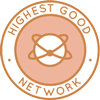 One Community is creating community conservation through diversification through open source Highest Good Network® software that is a web-based application for collaboration, time tracking, and objective data collection. The purpose of the Highest Good Network is to provide software for internal operations and external cooperation. It is being designed for global use in support of the different countries and communities replicating the One Community sustainable village models and related components.
One Community is creating community conservation through diversification through open source Highest Good Network® software that is a web-based application for collaboration, time tracking, and objective data collection. The purpose of the Highest Good Network is to provide software for internal operations and external cooperation. It is being designed for global use in support of the different countries and communities replicating the One Community sustainable village models and related components.
- Learn about our open source community collaboration and management software: The Highest Good Network
This week, the core team continued their work on the Highest Good Network PR testing and confirmed fixes for several issues, including the leaderboard header (#3018), the placement of lists on the Reports page for Projects, People, and Teams (PR 3190), the population of data upon input click (#3201), updates to the reusable form (#3145 and #1224), the implementation of a People Report bio toggle (#3218), the elimination of the need for additional saving in the Quick Setup Tool (#3031), improvements to the purchase request reusables (#3221), and the addition of a toggle request for the bio permission (PR 2289). Unresolved issues included design problems on narrow screens for the Projects/People/Teams page (PR 2473), the fixed width requirement for the User Management title column (PR 3177), profile page issues (PR 3187), and the QSC color not changing (#3227). Additionally, they recorded a video detailing an issue with the accuracy of the first and last day and the auto-refresh function on deactivation (PR 3176) and assigned a task to volunteer to fix the “Team Weekly Summaries” on Darkmode (6 hours). These improvements represent incremental steps towards the realization of community conservation through diversification. See the Highest Good Society and Highest Good Network pages for more on how this relates to community conservation through diversification. The collage below shows some of their work.
ALPHA SOFTWARE DEVELOPMENT TEAM
This week, the Alpha Team’s summary, covering their work on the Highest Good Network software, was managed by Lin Khant Htel (Frontend Software Developer) and the team includes Eve Ye (Volunteer Software Engineer Intern), Jiaqi Nie (Software Engineer), Nikita Kolla (Full Stack Developer), Rupa Rajesh Bhatia (Software Engineer), Sujith Reddy Sudini (Full-Stack Software Developer) and Vinay Vallabineni (Software Engineer). This software is a foundation of One Community tracking and management process for community conservation through diversification.
Lin reviewed and approved PR #1284 after familiarizing himself with the codebase and successfully running all 14 test cases locally. He consulted with team members, reviewed Alpha Team’s weekly summaries, photos, and videos, and continued his leadership duties—contributing to the overall goals of community conservation through diversification. Sujith refined the HTML structure and styling of the activity comments section to improve usability and responsiveness, laying a solid foundation for backend integration and ensuring alignment with the platform’s design.
Eve improved the Pinterest OAuth integration by switching to the more secure ‘authorization_code’ flow and adding a “Connect to Pinterest” button that manages token storage and renewal. Jiaqi merged notification and user bid endpoints, created a new listing schema, rewrote dependent APIs, and tested them using Postman—both contributing to community conservation through diversification through enhanced system functionality. Nikita resolved dark mode issues on the “Team Weekly Summaries” page and began addressing additional bugs, ensuring consistent visual design and accessibility across the app.
Rupa restructured the multi-step form with modular React components, integrated interactive UI elements, and optimized state management using hooks. She also enabled digital signatures, persistent user preferences, and real-time validation while collaborating across teams to refine features and support leadership development—all aligned with community conservation through diversification. Vinay developed dynamic scoring and ranking logic for the questionnaire dashboard, updating the data pipeline to retrieve average scores with team-based filters, and pushed the updated code to the repository. See the Highest Good Society and Highest Good Network pages for more on how this relates to creating community conservation through diversification. See below for some of the team’s work.
BINARY BRIGADE SOFTWARE DEVELOPMENT TEAM
The Binary Brigade Team’s summary overseeing advancements in the Highest Good Network software was managed by Aureliano Maximus (Volunteer Software Engineer) and includes Amalesh Arivanan (Software Engineer), Anirudh Sampath Kumar (Software Developer), Deepthi Kannan (Software Engineer), Geeta Matkar (Software Engineer), Jaissica Hora (Software Engineer), Nikhil Routh (Software Engineer), Sabitha Nazareth (Software Engineer), Sidhartha Sunkasari (Software Engineer), Sriram Seelamneni (Software Engineer), Samman Baidya (Software Engineer), Sunil Kotte (Full Stack Developer), Vasavi Vuppala (Software Engineer), and Wangyuan Chen (Software Engineer). The Highest Good Network software is how we’ll be managing and objectively measuring our progress in creating community conservation through diversification through our social architecture, construction, production, and maintenance processes.
This week, Amalesh reviewed 15 pull requests (#1288, #1294, #3313, #3319, #3322, #3325, #3327, #3332, #3335, #3337, #3338, #3342, #3343, #3345, #3346, #1298), which covered frontend and backend features including dashboard metrics, tag endpoints, calendar views, and leaderboard logic—each contributing to creating community conservation through diversification—documenting each with screenshots and uploading them to a shared folder. He also implemented PR #3356 to add a TSA Form to the HighestGoodNetwork app with navigation and validation logic. Anirudh worked on three pull requests, resolving merge conflicts and errors in test files, fixing a search bar bug, and updating overlapping code, each change reinforcing our broader goal of creating community conservation through diversification. This week, Aureliano became familiar with management responsibilities by completing the previous week’s tasks as practice and updating their weekly summary to reflect a manager’s perspective aligned with creating community conservation through diversification. He addressed a file upload issue where files were not resetting to null when users attempted to re-upload the same file. Deepthi addressed a responsiveness issue affecting leaderboard headers on high-resolution devices by replacing a fixed breakpoint with a dynamic condition based on screen width, supporting both visual clarity and our commitment to creating community conservation through diversification, and is collecting feedback for further refinements.
Geeta began work on the social media dashboard by analyzing key metrics and components from platforms like LinkedIn to guide future development and frontend UI adjustments that align with creating community conservation through diversification. Jaissica fixed linting issues on a donut chart and ensured visual consistency across light/dark modes and screen sizes, while also building backend endpoints to retrieve buildingTools data and reviewing weekly summaries for four team members, further reinforcing the mission of creating community conservation through diversification. Nikhil continued the migration to CSS Modules by converting .css files to .module.css format in the src directory, modifying 108 JSX files and resolving class reference issues in a manner that supports the broader vision of creating community conservation through diversification. Sabitha Rachel Nazareth worked on the listings and bidding platform for the Highest Good Housing project by writing APIs to fetch, update, and add villages, setting up the corresponding routes and controllers, and beginning the logic to filter villages based on specific criteria—all of which contribute to creating community conservation through diversification—with plans to clarify a related doubt with Jae. Sidhartha Sunkasari added a date range and comparison filter to the TotalOrgSummary page in the frontend and began backend updates to handle new comparison values that align with our strategy of creating community conservation through diversification.
Sriram worked on the TimeLogger component, resolving time synchronization issues and adding a search function by team, username, and role, each refinement reflecting our principles around creating community conservation through diversification. Samman worked on Phase III navigation bar updates, organizing menus and routes, integrating them into the dropdown, and addressing styling issues, while also progressing on the “Share PDF” task—all part of our efforts in creating community conservation through diversification. Sunil refined frontend logic in the Weekly Summaries Reports page to properly filter deactivated users by creation date, adjusted how the _id field is interpreted, and created pull requests for the updates—steps that support our focus on creating community conservation through diversification. Vasavi resolved a UI issue in the Dashboard > Tasks > Progress Column using CSS adjustments and fixed linting errors in the src/components/Projects and UserProfile directories, both efforts contributing to creating community conservation through diversification. Kaia implemented a new email assignment module for Weekly Summary BCC recipients. The feature allows users to search, add, and remove recipients via a dynamic modal interface, reinforcing usability in support of creating community conservation through diversification. See the Highest Good Society and Highest Good Network pages for more on how this relates to creating community conservation through diversification. View some of the team’s work in the collage below.
BLUE STEEL SOFTWARE DEVELOPMENT TEAM
The Blue Steel Team’s summary, presenting their work on the Highest Good Network software was managed by Sheetal Mangate (Software Engineer) and includes Humemah Khalid (Software Engineer/Backend Developer), Ramakrishna Aruva (Software Engineer), Sai Girish Pabbathi (Software Engineer), Sharan Sai Marpadaga (Software Developer) and Srichand Medagani (FullStack Developer). The Highest Good Network software is how we’ll be managing and objectively measuring our process for community conservation through diversification.
This week, Sai focused on tasks assigned by Jae, including displaying popups, filtering by date, using icons, and handling profile pages. He completed the CSS for properties to allow viewing on the same page as listings and spent time reviewing Airbnb’s interface to understand typical user interface patterns for day-to-day use, contributing to community conservation through diversification by improving the platform’s accessibility. Ramakrishna identified the root cause of a state management issue where the userProfile state, specifically the project’s data, was not updating correctly, leading to outdated data being sent to the backend. He explored solutions using Promises and useState to address the issue, implementing a solution to update the project’s data based on the previous userProfile state, which aligns with the goals of community conservation through diversification. After pulling the latest development changes, he made necessary adjustments and reviewed the updated codebase to ensure alignment with the current implementation. Humemah worked on the ‘HGN Questionnaire Dashboard: Backend: Implement Community Members List with Filtering, Sorting, and Search’ task, ensuring data retrieval and confirming the GET endpoint’s functionality, enhancing community conservation through diversification by improving data management. He also worked on the weekly summary and uploaded the corresponding Dropbox images, with filtering and sorting features still in progress.
Srichand worked on fixing the default 404 error page implementation and redirection. He analyzed the task details, ensured the error page displayed correctly for unsupported or invalid URLs, and included links for navigating to the dashboard and opening the Suggestions/Development modal. He identified issues with the previous PR and reviewed the NotFoundPage implementation to correctly place routing, layout, and modal logic, using ChatGPT to research connecting components and sharing modal state across the app. Sharan worked on understanding the requirements for building the Additional Notes and Work Experience section on the user page, reviewing the APIs to fetch the necessary information and gaining an understanding of how to begin implementing the section. Sheetal completed the task functionality for “Development for Re-Engagement Strategies,” performing code cleanup and a code review for the pull request. She also worked on the CSS to adjust the alignment of the form fields from the noShoList popup and added an error message at the bottom of the popup, replacing the previous alert system. Sheetal tested the functionality to ensure everything was working as expected. See the Highest Good Society and the Highest Good Network pages to learn more on how their work contributes to community conservation through diversification. See below to view images of their work.
CODE CRAFTERS SOFTWARE DEVELOPMENT TEAM
The Code Crafters Team, covering their work on the Highest Good Network software, was managed by Sundar Machani (Software Engineer) and includes Anjali Maddila (Software Engineer), Ashrita Cherlapally (Software Engineer), Denish Kalariya (Software Engineer), Humera Naaz (MERN developer), Kshitij Gugale (Software Engineer), Pavan Swaroop Lebakula (Software Engineer), Pratyush Prasanna Sahu (Software Engineer), Rohith Nayakar (Full Stack Developer), Sai Moola (Software Engineer), Sanjeevkumar Hanumantlal Sharma (Software Engineer) and Xiaolei Zhao (Software Engineer). The Highest Good Network software is how we’ll manage and objectively measure our process for community conservation through diversification through our social architecture, construction, production, and maintenance processes.
This week, Sundar worked on the HGN Software Development project focused on building the frontend for the “Paid Labor Cost” grouped-bar chart component within the Phase 2 Summary Dashboard. He created the base card structure, explored relevant data fields for UI mapping, added filters for tasks, projects, and dates, styled the dropdown using custom CSS, integrated an Airbnb-style date picker, implemented sorting logic to display tasks by ascending cost with the top two highlighted, adjusted mock data to fit the required structure, and updated the layout and styling to match the Figma design, contributing to community conservation through diversification. Rohith resolved a dropdown issue in the Weekly Summaries Report component by using global SCSS styles and created a dedicated branch with the fix. He also began working on the Newell refactor of the Weekly Summary component and contributed to the Carlos anniversary feature and Volunteer Hours Distribution update, aligning with the project’s goal of community conservation through diversification. Sai Shekhar linked a button on the initial modal to the openSuggestions modal on the dashboard, adjusted the dropdown dimensions, raised PR #3357, resolved issues from a rebase by reverting certain commits, and began work on a backend task. Xiaolei submitted PR #1302 to add a GET /lessons-learnt endpoint for the BM dashboard backend, enabling filtering by projectId and date range, aggregating lesson counts, and calculating month-over-month percentage change, and began exploring requirements for the Loss Tracking Line Graph backend, which supports the broader vision of community conservation through diversification.
Anjali addressed an error related to user name display when switching tabs and raised PR #3319 for the fix, then implemented a tracking button in the permission management section. Community conservation through diversification was an important consideration in the feature’s implementation. Pratyush reviewed several pull requests, including PRs 3373, 3372, 3370, 3368, 3367, and 3365, checking functionality, mobile responsiveness, lint errors, and UI appearance across themes. He also worked on the material dashboard summary task, fixed lint issues, and prepared a pull request. Sanjeevkumar completed five APIs for financial summaries with assumptions for labor time data, began gathering requirements, and started developing the backend API for the “Distribution of Labor Hours” pie chart in the Phase 2 Summary Dashboard. Ashrita integrated React Query and Axios for data fetching with a loading animation, developed tooltip hover functionality to display tag frequency, added basic click functionality, and faced challenges with font scaling logic and syncing date filter updates in the mind map rendering, further supporting the goals of community conservation through diversification.
Denish investigated a performance issue affecting the profile page by simulating recent changes in a controlled environment to isolate causes of the slowdown, comparing performance metrics, and reviewing modified components. Humera implemented a compressed zip file solution to manage user and login data using gzip headers, aiming to improve data handling efficiency. Pavan analyzed layout issues in the dashboard’s timer panel caused by a previous pull request and worked on adjusting the implementation to restore the prior appearance without affecting other components. Kshitij updated styles in `AddTaskModal.css` and adjusted elements in `AddTaskModal.jsx` to fix layout issues in the Add Task modal. He investigated why UI changes weren’t appearing by clearing the build cache, reinstalling dependencies, and rebuilding the app. Changes were committed and pushed on the correct branch, `hotfix/fix-wbs-add-task-format`. The issue seemed related to Webpack or browser caching, or how Hot Module Reloading handles file updates. See the Highest Good Society and Highest Good Network pages for more on how this relates to community conservation through diversification. View some of the team’s work in the collage below.

DEV DYNASTY SOFTWARE DEVELOPMENT TEAM
The Dev Dynasty Team’s summary, covering their work on the Highest Good Network software, was managed by Nishita Gudiniye (Software Engineer) and includes Honglin Chen (Software Engineer), Mohan Satya Ram Sara (Software Engineer), Jatin Agrawal (Software Engineer), Shraddha Shahari (Software Engineer), Tanvi Anantula (Software Engineer), Vaibhav Koladiya (Software Engineer), Vamsi Krishna (Software Engineer) and Zhifan Jia (Software Engineer). The Highest Good Network software is how we’ll manage and objectively measure our process for community conservation through diversification through our social architecture, construction, production, and maintenance processes.
This week, Honglin completed PRs 765 and 1984, adding actions, reducers, and toast notifications for updating and deleting inventory types and units of measurement. He also reviewed pull requests older than six months and documented their status—ready to merge, close, or reassign—contributing to the goals of community conservation through diversification. Jatin tackled bugs in the email auto-reply system, implemented workflows for various user completion scenarios, and finalized messaging updates for the lbdashboard. Mohan began setting up permission-based access control for the HGN skill dashboard, reviewed the database structure, and drafted integration plans to ensure scalability in line with community conservation through diversification.
Nishita enhanced dark mode for the event registration confirmation modal and the “Event Personalization” page, aligning both with the design system. She also prepared for managerial duties by reviewing training materials, supporting community conservation through diversification through team leadership. Shraddha addressed multiple bugs, including issues with the Equipment List update button, Featured Badges, badge assignments, and email functionalities, contributing to system stability and the overarching mission. Tanvi submitted a new, conflict-free pull request to replace a previously problematic one, ensuring smooth deployment processes aligned with community conservation through diversification.
Vaibhav developed a refresh notification popup, resolved display issues by implementing a new hash function, and created an update-hash.yml file to automate updates. He tested the feature and reviewed several pull requests for HighestGoodNetworkApp, advancing the goals of community conservation through diversification. Vamsi created a permission feature to track how often tasks are extended, added a corresponding option in the frontend, and aligned this functionality with platform goals. Zhifan completed backend functions for a donut chart visual, resolved multiple Node.js-related issues, tested with synthetic data, submitted a pull request with video proof, and updated prior PR names—supporting project consistency and community conservation through diversification. See the Highest Good Society and Highest Good Network pages for more on how this relates to community conservation through diversification. View some of the team’s work in the collage below.
EXPRESSERS SOFTWARE DEVELOPMENT TEAM
The Expressers Team’s summary, covering their work on the Highest Good Network software, managed by Strallia Chao (Software Engineer), includes Ghouse Shahe Meera Ziddi Mohammad (Software Engineer Intern), Meenashi Jeyanthinatha Subramanian (Full Stack Developer), Rahul Trivedi (Software Engineer) and Reina Takahara (Software Developer). The Highest Good Network software is how we’ll manage and objectively measure our process for community conservation through diversification through innovative software development, testing, and collaboration. This week, Ziddi continued work on the listing dashboard, focusing on fetching availability data for each unit. This involved identifying booked appointments, checking for pending reservations, and ensuring that time slots are made available when reservations are cancelled. To support this functionality, he began developing the necessary APIs, with an estimated requirement of three to four endpoints to complete the task.
Meenashi set up the webhook event controller and routes, then simulated events using Cloudflared. The bidAndPay details matching the screen were triggered, resulting in the creation of the PAYMENT.AUTHORIZATION.CREATED event, which in turn called the webhook. However, the webhook initially failed due to a 401 unauthorized error caused by the middleware.js file. After resolving the authorization issue and returning a success response, she observed that the webhook code was still not executing and continued investigating the issue. The efforts put in by Meenashi contribute to community conservation through diversification by ensuring smooth technical operations. Rahul worked on the HGN Questionnaire Dashboard by integrating the User Profile Page into the main application. He created a new branch and pushed the code. Backend API endpoints were connected to enable real-time data display, and frontend styling was improved for better responsiveness and visual accuracy. He added a GitHub section to user contact information, included a skills chart to display user skills, integrated Manoj’s backend API, and suggested data structure updates to better meet project requirements, further supporting community conservation through diversification.
Reina re-familiarized herself with the code base and selected a new task to create an interactive map showing project locations for Phase 2. After resolving local setup issues by updating her software, she created a new route for the interactive map and implemented it using Leaflet JS. She began populating the backend with fake data and started working on retrieving and displaying that data on the frontend. Strallia reviewed PR #3332 related to the Global Volunteer Map on the Total Org Summary Page. She provided feedback, reverted out-of-scope commits, added a loading icon, resolved merge conflicts, and integrated the backend API for custom date selection in the Volunteer Trends Line Chart. Additionally, she updated the progress tracking sheet to reflect frontend chart changes. See the Highest Good Society and Highest Good Network pages for more on how this contributed to community conservation through diversification. See the collage below to view the team’s work.
LUCKY STAR SOFTWARE DEVELOPMENT TEAM
The Lucky Star Team’s summary of the Highest Good Network software, was managed by Anne Zhang (Software Engineer) and includes contributions from Barnaboss Puli (Volunteer Software Engineer), Chetan Sunku (Software Engineer), Dipti Yadav (Software Engineer), Harini Korda (Software Engineer), Koushica Bosadi Ulaganathan (Software Engineer), Manoj Gembali (Software Engineer) and Vaibhavi Madhav Deshpande (Software Engineer). This improvement fostered a sense of ownership, much like that seen in community conservation through diversification where collective action drives progress.
This week, Barnaboss worked on improving code quality and developing backend features for the Phase 2 Summary Dashboard of the HGN Software project, resolving ESLint and Prettier issues in the src/components/TeamMemberTasks/ directory and submitting a pull request, while also working on caching and backend logic for visualizations including a Donut Chart for Project Status and a Bar Graph for Total Material Cost per Project, encountering and addressing mongosh authentication issues. Chetan continued work on fixing the “i” popup icon issue on the Weekly Summaries Reports page, focusing on ensuring popups appear correctly for roles other than “Volunteer” and are editable by Owners, with implementation and verification in progress. This improvement fostered a sense of ownership, much like that seen in community conservation through diversification where collective action drives progress.
Dipti completed task 763 related to saving and auto-populating Work Breakdown Structure content during auto-refresh, submitting backend and frontend pull requests (PR 1298 and PR 3346), and began work on a new issue related to the archive button not functioning, which involved investigating relevant files and identifying necessary fixes. Harini resolved merge conflicts and deployment issues in the Global Volunteer Map component, updated the Total Org Summary dashboard to improve the map and volunteer location display, addressed Netlify deployment warnings, and worked on the “Total People Report Hours” task by updating a label from “Total Logged Time” to “Total Tangible Logged Time.” Koushica resolved autosave issues in the user profile’s Quick Setup section, fixed bell notification behavior related to bar data load times, and implemented a hotfix for UI breakage caused by a new CSS file, while also starting a discussion on longer-term CSS management solutions. This improvement fostered a sense of ownership, much like that seen in community conservation through diversification where collective action drives progress.
Manoj added logging and permission authentication to a backend endpoint, created PR #1301 with screenshots, and began frontend development for the new Community Members HGN Help page by reviewing the task and Figma designs and setting up routes and components. Vaibhavi reviewed multiple pull requests for code quality and functionality, tested updates for system stability, and worked on advancing her own pull requests by refining features, testing, and preparing them for review. Anne worked on debugging a new bug related to saving blue square reasons for specific One Community roles, managed the Lucky Star team’s reviews and pictures of the week, and answered questions from team members regarding tasks and responsibilities. See the Highest Good Society and Highest Good Network pages for more on how this relates to community conservation through diversification. See the collage below to view the team’s work.
MOONFALL SOFTWARE DEVELOPMENT TEAM
The Moonfall Team’s summary, covering their work on the Highest Good Network software was managed by Newell Newell (Manager) and includes Angad Anil Gosain (Volunteer Software Engineer), Bhavpreet Singh (Software Engineer), Calvin Liu (PR Team), Lalith Kumar Rajendran (Software Engineer), Nikhil Giri (Software Engineer), Samhitha Gouru (Software Engineer), Shashank Kumar (Software Engineer), Sravya Kotra (Software Engineer), Vivek Sharma (Software Engineer), and Yili Sun (Software Engineer). This week, Angad reviewed multiple pull requests, validated backend endpoints, resolved layout, and logic issues, made UI improvements, and addressed test warnings and formatting problems before submitting a final pull request. Bhavpreet updated the wishlist model schema, routes, and controller functions to match frontend changes and replaced a custom image carousel with a Bootstrap version for ease of use, contributing to the broader goals of community conservation through diversification.
Lalith modified the handling of admin and owner role permissions by removing hardcoded logic and integrating it into the permissions management flow. Newell worked on implementing CASL-based attribute-based access control policies using PostgreSQL and Nest.js, protected backend domains with Cloudflare, completed Azure NSG and Cloudflare Firewall protection, addressed Azure-related issues, and worked on file uploading and new backend endpoints in Nest.js. Samhitha worked on designing and developing a bar graph to display the risk profile of projects, including a labeled X-axis with project names and color-coded bars for predicted cost overruns, time delays, and open issues, along with dropdown filters for project and date selection and dynamic filtering logic, which ties into community conservation through diversification by ensuring better project management. Shashank focused on making components responsive across screen sizes, studied PayPal’s SDK for checkout, customized card payment input fields using developer credentials, and worked around incomplete backend APIs.
Sravya fixed layout issues in the User Management UI by identifying the cause of recent CSS changes and applying a hotfix to restore alignment, spacing, and link color, which helps streamline the user interface as part of the effort towards community conservation through diversification. Yili worked on unit tests for profileInitialSetupController.js, refactored logic for better testability, resolved merge conflicts in multiple pull requests, and addressed change requests related to user permissions and editing team codes. See the Highest Good Society and Highest Good Network pages for more on how this relates to creating community conservation through diversification. Below is a collage for the team’s work.
REACTONAUTS SOFTWARE DEVELOPMENT TEAM
Reactonauts’ Team’s summary, covering their work on the Highest Good Network software, was managed by Vijeth Venkatesha (Software Engineer) and includes Akshay Jayaram (Software Engineer), Ghazi Rahman (Software Engineer Intern), Gmon Kuzhiyanikkal (Software Engineer), Guirong Wu (Software Engineer), Haoyue Wen (Software Engineer), Keying Guo (Software Engineer), Khushi Jain (Software Engineer), Mohan Gopi Gadde (Software Engineer), Nikhil Pittala (Software Engineer), Pallavi Thorat (PR Team O-Sh), Peterson Rodrigues (Full-Stack MERN Stack Developer), Rishitha Mamidala (Software Engineer), Rishwa Patel (Software Developer), Saniya Farheen (Software Engineer), Sharadha Shivakumar (Software Engineer), and Xiyan Li (Software Engineer Intern). This software is a foundation of One Community tracking and management process for supporting the abundance of the earth.
This week, Akshay focused on backend validation for user profiles, investigating the missing timeZone property through MongoDB queries, API inspections, and cache checks. He reviewed the Mongoose schema, restarted servers after each change, and used Postman to test real-time data responses, aligning his efforts with community conservation through diversification. Ghazi enhanced the financial summary cards by refining spacing, font styles, tooltips, and responsiveness. He optimized layouts for mobile and desktop views, tested UI consistency, and initiated a PR for dynamic button population, contributing to community conservation through diversification.
Gmon addressed hidden member tasks and added bell notifications based on task deadlines. He submitted PR 2850 for review, organized reference materials, and explored the project’s architecture, contributing to community conservation through diversification. Guirong resolved multiple formatting and editability issues in the Reports section and introduced a new contributors report filter with editable icons, all supporting community conservation through diversification. Haoyue fixed merge conflicts and ESLint errors for the FAQ tool and began developing analytics for job posting data visualization, aligning with community conservation through diversification. Khushi created a responsive Phase 2 Summary Dashboard pie chart with filters and interactive hover features, also implementing dark mode to support accessibility and community conservation through diversification.
Mohan updated the badge assignment system to support assigning multiple badges to multiple users, modifying front-end and back-end logic to ensure flexibility and compatibility, aligning with community conservation through diversification. Nikhil reviewed 14 pull requests across the stack, providing feedback and verifying functionality to maintain high code quality and support global sustainability strategies. Pallavi implemented a modal and backend system for question editing in the form builder, including template management with full CRUD support and user-level access control, all contributing to community conservation through diversification. Peterson resolved two 404 page bugs related to URL structure errors, supporting global sustainability through improved user experience.
Rishitha developed a bar chart with filters to visualize issue types and counts, supporting data clarity and community conservation through diversification. Rishwa set up the routing and folder structure for the HGN Help Skills Dashboard, creating key components and ensuring a clean Git commit history, reinforcing a scalable design that contributes to community conservation through diversification. Saniya worked on Figma mockups and iterated on feedback to improve wireframe design, aligning her updates with open-source global sustainability strategies. Sharadha improved the Job Posting UI and resolved merge conflicts on event registration features, submitting clean PRs that support community conservation through diversification.
Xiyan developed a URL shortening service with API integration, history tracking, and clipboard functionality using TypeScript for enhanced maintainability and usability, aligning with community conservation through diversification. Vijeth focused on team coordination and MongoDB performance optimization, reviewing summaries and addressing system slowdowns to ensure better functionality, contributing to the broader goals of community conservation through diversification. See the Highest Good Society and Highest Good Network for more on how this contributed to ecological global transformation. See the collage below to view the team’s work.
SKYE SOFTWARE DEVELOPMENT TEAM
Skye Team’s summary, covering their work on the Highest Good Network was managed by Olimpia Borgohain (Data Analyst and Team Admin) and Luis Arevalo (Software Engineer) and the team includes Sai Preetham (Full Stack Developer), Snehal Dilip Patare (Software Engineer), Vikas Nomula (Software Engineer) and Yao Wang (Software Engineer). The Highest Good Network software helps manage and objectively continue with supporting open sourcing community conservation through diversification, focusing on social architecture, construction, production, and maintenance processes to build sustainable and thriving ecosystems. This solution is portable, scalable, and ideal for off-grid or sustainable living communities.
This week, Luis resolved a grey icon issue in the warning popup by identifying a styling conflict and created a pull request. He explored YouTube API options for automating community posts but suggested switching tasks after finding no suitable solution. He also discussed potential improvements to the warnings component with Jae, by contributing to community conservation through diversification enhancing the user experience. Sai Preetham integrated a calendar-style time picker into the Materials page, resolved merge conflicts, and raised a pull request. He began analyzing the role-change confirmation modal task and revisited a tracking management task based on feedback, confirming its functionality and creating a demonstration video, further supporting the objectives of community conservation through diversification.
Snehal implemented Facebook post scheduling functionality, updated backend components, unified Twitter and Facebook functionality into a single interface, and added post scheduling options with history display on the frontend. Vikas worked on the YouTube autoposter task but the work was paused due to API limitations, and focus shifted to developing an autoposter for Medium, which provides an API for posting content. Yao refined backend and frontend implementations of the Reddit Auto Poster feature and created a handoff document outlining the status of Reddit and LinkedIn auto poster features for future development. See the picture below for the work done by the team on community conservation through diversification.
SOFTWARE PR REVIEW TEAM A-E
The PR Review Team’s summary for team members’ names starting with A-E and covering their work on the Highest Good Network software was managed by Saumit Chinchkhandi (Administrative Assistant and Software Engineer). The Highest Good Network software is a foundation of what we’ll be using to measure our results of community conservation through diversification. This week’s active members of this team were: Abdelmounaim Lallouache (Software Developer), Akanksha Singh (Software Developer), Carl Bebli (Software Engineer), Carlos Gomez (Full-Stack Software Developer), and Dharmik Patel (Software Engineer). They assisted with the research for community conservation through diversification by reviewing all the Highest Good Network PRs (Pull Requests) shared in this week’s update. Learn more about how the Highest Good Network measures community conservation through diversification by exploring the Highest Good Network open-source hub. The collage below shows a compilation of the work from this team.
SOFTWARE PR REVIEW TEAM F-M
The PR Review Team’s summaries for team members’ names starting with F-M and covering their work on the Highest Good Network software was managed by Anoushka Hazari (Data Analyst). The Highest Good Network software is a foundation of what we’ll be using to measure our results for community conservation through diversification. This week’s active members of this team were: Ganesh Karnati (Software Engineer), Greeshma Palanki (Software Engineer), Kurtis Ivey (Full Stack Developer), Linh Huynh (Volunteer Software Engineer), Manusha Jyasta (Senior Software Engineer), and Manvitha Yeeli (VolunteerSoftware Engineer). They reviewed all the Highest Good Network PRs (Pull Requests) shared in this week’s update. Learn more about how the Highest Good Network will measure and assist in community conservation through diversification in the Highest Good Network open source hub. The collage below shows a compilation of the work from this team.
SOFTWARE PR REVIEW TEAM N-R
The PR Review Team’s summaries for team members’ names starting with N-R and covering their work on the Highest Good Network software was managed by Govind Sajithkumar (Software Project Manager). The Highest Good Network software is a foundation of what we’ll be using to measure our results of community conservation through diversification. This week’s active members of this team were: Nahiyan Ahmed (Full Stack Software Developer), Nathan Hoffman (Software Engineer) and Ravikumar Sripathi (Software Engineer). They reviewed all the Highest Good Network PRs (Pull Requests) shared in this week’s update. Learn more about how the Highest Good Network measures community conservation through diversification by exploring the Highest Good Network open-source hub. The collage below shows a compilation of the work from this team.
SOFTWARE PR REVIEW TEAM S-Z
The PR Review Team’s summaries for team members’ names starting with S-Z and covering their work on the Highest Good Network software was managed by Jaiwanth Reddy (Software Project Manager). The Highest Good Network software is a foundation of what we’ll be using to measure our results of community conservation through diversification. This week’s active members of this team were: Siva Putti (Software Engineer) and Yiyun Tan (Software Engineer). They reviewed all the Highest Good Network PRs (Pull Requests) shared in this week’s update. Learn more about how the Highest Good Network measures community conservation through diversification by exploring the Highest Good Network open-source hub. The collage below shows a compilation of the work from this team.
AND WE PRODUCED THIS WEEKLY UPDATES BLOG – CLICK HERE TO SUBSCRIBE
FOLLOW ONE COMMUNITY’S PROGRESS (click icons for our pages)
INVESTOR PAGES
GET INVOLVED
DONATE | WAYS ANYONE CAN HELP | MEMBERSHIP
CLICK HERE FOR ALL PAST UPDATES
 One Community
One Community